
Classic Buses Profiles
Southdown Leyland Tigers - Southdown coaches 1951 - 1961 (by Dick Gilbert)
Last updated 22 July 2022

SOME LINKS WITHIN THIS WEBSITE:
Home
Email
Links
THE COMPLETE WEBSITE MENU
Events Diary
Halfcab list
Small-Ads
Classic Irish Buses
Classic Manx Buses
This page is a profile of the early underfloor-engined coaches that Southdown Motor Services acquired
between 1951 and 1961.
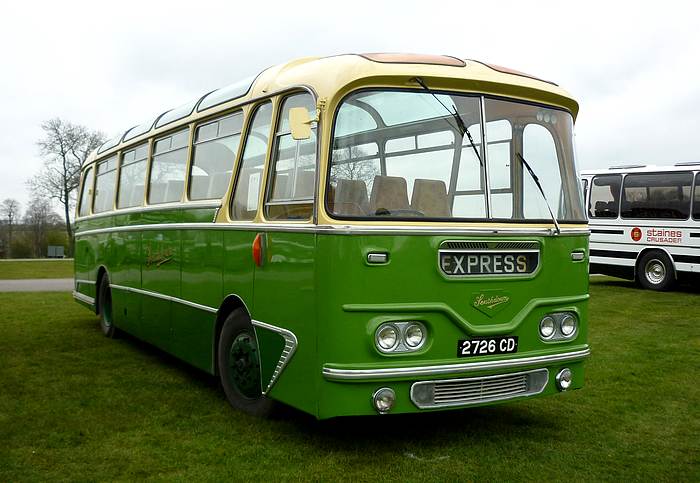
For many people, the classic image of a post-war Southdown touring coach is that of their fleet of
Harrington Cavaliers, which entered service in 1961, the very end of the period covered by this profile. Undoubtedly one of the
great style icons of post-war coachbuilding, the Southdown Cavaliers looked at their best (in my opinion!) when wearing the cream
and leaf green livery in which they were delivered. That livery was short-lived, but showed off the design to its greatest
advantage, as demonstrated by no. 1726 (one of four in preservation), seen here at the Maidstone and District and East Kent bus
club's 60th anniversary event at the Kent County Showground, Detling in April 2012. Photo: Dick Gilbert.
INTRODUCTION AND CREDITS
Southdown had long held a reputation for quality coach services and, with the halfcab design
considered somewhat old-fashioned by the early 1950s, and the remainder of their huge fleet of front-engined Leyland Tigers getting
long in the tooth, it was natural that they would look closely at the new underfloor-engined coaches then coming on to the market.
In the decade from 1951, when they bought their first examples, and 1961, as the first of many
stylish Harrington Cavaliers started to arrive, Southdown bought over 400 coaches, mostly Leylands but also some Commer two-strokes,
and this is a profile of those acquisitions.
Often bulky and solid, sometimes almost brutish in design, they nonetheless reflected the styling of
the 1950s, perhaps the coaching equivalent of the Standard Vanguard, the Hillman Minx or the early diesel loco.m.o.tives, without
venturing into the excesses of the Wurlitzer jukebox. The various body manufacturers had their products subtly varied by the
company and thus became instantly recogniseable as Southdown vehicles, with their extensive window area and patterned brightwork on
the front.
The style of brightwork first appeared on Southdown's 1951 Duple Ambassadors (Royal Tigers 800-809)
but was later adopted for use on their Harrington Wayfarers, Beadle coaches, Commer/Beadle Rochesters and even the all-Leyland Royal
Tigers.
Services were operated under various titles, including Beacon Tours (named after Beacon Motor
Services of Crowborough, acquired by Southdown in 1949), Triumph Coaches, a Portsmouth company taken over in 1957 and whose smart
blue and cream livery was applied to 21 Southdown coaches at various times through to the early 1960s, and Buck's Coaches of
Worthing, whose cream / pale blue livery was applied to two Royal Tigers in the mid 1960s. The South Coast Express title was used
for a fast coastal service from Bournemouth to Margate, operated jointly with East Kent and Royal Blue. Linjebuss was a Swedish
tour operator who used a small number of Southdown coaches (in their blue livery) for tours of Britain.
What follows is an attempt to create a brief history of the type, in the form of records and images
designed to give even the casual reader some impression of the development and contemporary styling of this varied and interesting
fleet of coaches.
My thanks to all those who have helped with valuable data - too many to name I'm afraid.
As always, mistakes are inevitable and some relevant information may be missing so, in order to make
it as accurate a reference as possible, I would of course welcome any additions or corrections.
Since the list is arranged in order of delivery, the fleet numbers in this list are not in sequence.
For the benefit of those who may be looking for a particular vehicle or batch, the following lists in fleet number and registration
number order, linked to the appropriate batch, may be useful:
Fleet numbers:
Registration numbers
FLEET LIST
LEYLAND ROYAL TIGER - 800-829 (Total 30)
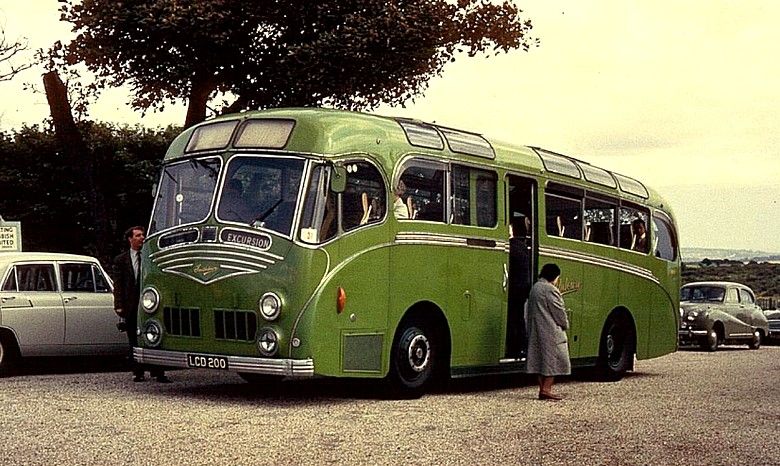
This is numerically Southdown's first underfloor-engined coach, seen on an excursion in the mid
1960s. Repainted into this livery and renumbered from 800 to 1800 in 1962, it was sold for work on construction sites four years
later - an ignominious retirement. Photo by kind permission of Cliff Essex.
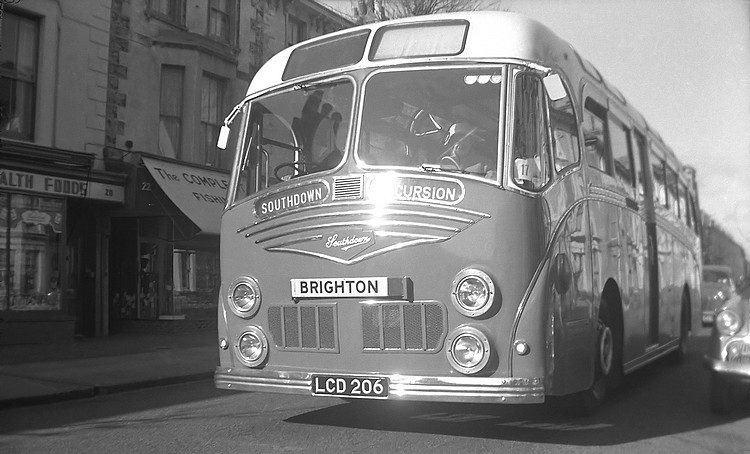
The first ten of this batch had Duple Ambassador bodywork, with distinctive Southdown brightwork
modifications. This is no. 1806 (LCD 206), previously numbered 806, heading along Pevensey Road, Eastbourne, approaching the
Southdown Coach Station in Cavendish Place after returning from a sunny day trip to Brighton in the summer of 1962. Looking
typically smart, it still retains its original attractive cream roof, which it was soon to lose. Photo: Dick Gilbert.
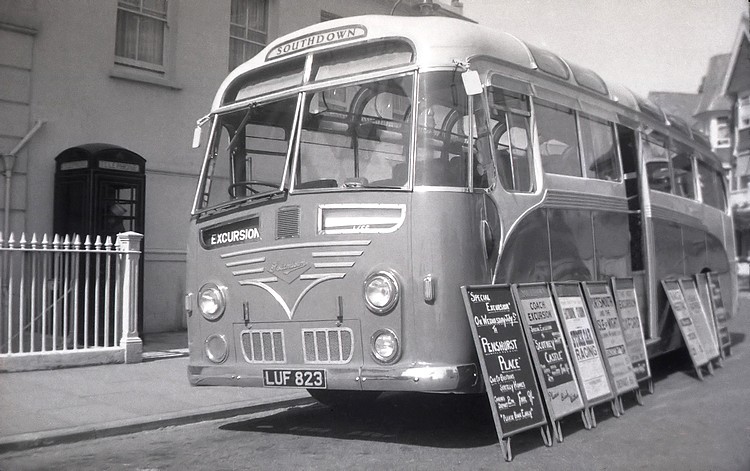
The second part of this batch had the Harrington Wayfarer coachwork, again seating a luxuriously
spacious 26. Royal Tiger 1823 (LUF 823) is seen opposite Eastbourne Pier at the very end of its touring coach life in the summer of
1961, touting for day-trip customers. It had been renumbered from 823 to 1823, but still retained its cream roof. Within a year it
had followed general Southdown policy to paint the whole coach fleet all-over leaf green, which detracted from the character of the
machines. It became no. 1683 at the same time, and was downgraded from touring to general coach duties, increasing the capacity to
41 seats. 1683 was sold in 1966. Photo: Dick Gilbert.
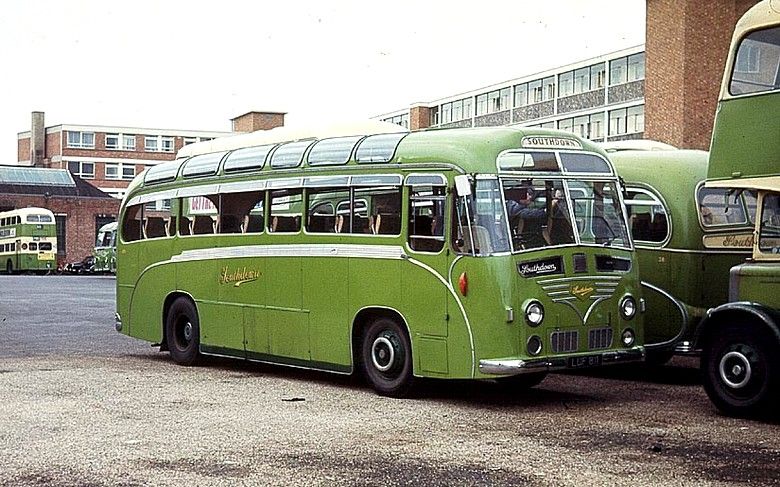
Here we see Royal Tiger 1811 (LUF 811) at Bognor Regis depot after having its Harrington body
repainted into the all-over leaf green livery applied in 1961. It was also renumbered 1671 around this time. Photo by kind
permission of Cliff Essex.
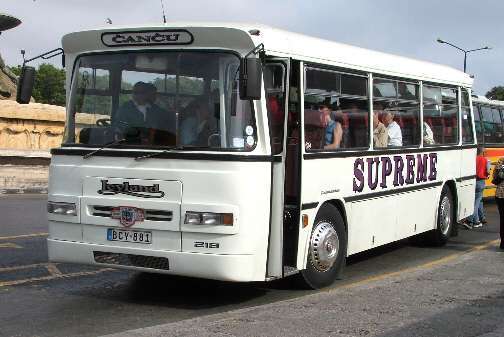
Still active in 2006, although unrecognisable since being rebodied by Brincat, Southdown Royal
Tiger no. 826 (LUF 826) continued to work regularly in Malta as BCY 881, and had been with the same owner since it arrived in 1972.
Photo by kind permission of Peter Skerry.
Built 1951-52
Chassis: Leyland Royal Tiger PSU1/15, 30 foot chassis, with O600 9.8 litre engines.
Body:
800-809; Duple Ambassador C26C tourers with sliding roof and two-and-one seating.
810-829; Harrington Wayfarer I, C26C tourers with sliding roof, intended for long-distance coach
cruises.
Notes: Southdown's first 30-foot underfloor-engined coaches. This batch was later renumbered 1800-
1829.
The Harrington-bodied examples were repainted all-over leaf green in 1961/2, converted to C41C, and
renumbered again as 1670-1689.
- 800 (LCD 200) - c/n 504772, b/n 56370. Deliv.5/51, based Brighton area 1954. Renumbered 1800 in 1956. Downgraded from touring to ordinary coach work in 1962 as C41C. Sold to dealer 1966, then to Murphy (contractor) 1966.
- 801 (LCD 201) - c/n 505541, b/n 56365. Deliv.5/51, based Brighton area 1954. Renumbered 1801 in 1956. Kept as C26C in 1962 to operated Brighton-Heysham part of Irish tours. Sold 1963 to Blackpool Corporation. In use with them for holiday pro.m.o.tions 1967, with large model of Blackpool Tower on the front! See photo by Marcus Parry here.
- 802 (LCD 202) - c/n 505542, b/n 56366. Deliv.5/51, based Brighton area 1954. Renumbered 1802 in 1956. Downgraded from touring to ordinary coach work in 1962 as C41C. Sold to dealer 1966, then to Rhymney Transport Services.
- 803 (LCD 203) - c/n 505543, b/n 56367. Deliv.5/51, based Brighton area 1954. Renumbered 1803 in 1956. Downgraded from touring to ordinary coach work in 1962 as C41C. Sold to dealer 1966. With Wimpey (contractor) 1967.
- 804 (LCD 204) - c/n 505544, b/n 56368. Deliv.5/51, based Brighton area 1954. Renumbered 1804 in 1956. Downgraded from touring to ordinary coach work in 1962 as C41C. Sold 1966. With Wimpey (contractor) 1968.
- 805 (LCD 205) - c/n 505785, b/n 56369. Deliv.5/51, based Brighton area 1954. Renumbered 1805 in 1956. Downgraded from touring to ordinary coach work in 1962 as C41C. - Sold 1966. To Rogers Tours, Navan, Ireland in 1968, became IAI 264. To McCormack, Drogheda 8/70, returned to Rogers, Navan 9/70.
- 806 (LCD 206) - c/n 505545, b/n 56371. Deliv.5/51, based Brighton 1954. Renumbered 1806 in 1956. Downgraded from touring to ordinary coach work in 1962 as C41C. Sold 1966. With Aherlow, Tipperary, Ireland 1970.
- 807 (LCD 207) - c/n 505947, b/n 56372. Deliv.5/51, based Brighton area 1954. Renumbered 1807 in 1956. Repainted all-over leaf green in 1961. Downgraded from touring to ordinary coach work in 1962 as C41C. Sold 1966.
- 808 (LCD 208) - c/n 505948, b/n 56373. Deliv.5/51, based Brighton area 1954. Renumbered 1808 in 1956. Repainted all-over leaf green in 1961. Downgraded from touring to ordinary coach work in 1962 as C41C. Sold 1966. With St. Kevin's Bus Service (P. Doyle), Roundwood, Co. Wicklow, Ireland in 1967-68.
- 809 (LCD 209) - c/n 510073, b/n 56374. Deliv.5/51, based Brighton area 1954. Renumbered 1809 in 1956. Became the first Royal Tiger to be sold, when it passed to H.E.Collins (building contractors) of Drayton, Portsmouth in 1963.
- 810 (LUF 810) - c/n 511267, b/n 999. Deliv.5/52, based Brighton area 1954. Renumbered 1810 in 1956, then again to 1670 in 1961 and converted to C41C. Sold 1966.
- 811 (LUF 811) - c/n 511268, b/n 1008. Deliv.1/52, based Brighton area 1954. Later renumbered 1811, then again to 1671 in 1961 and converted to C41C. Sold 1966. With Wimpey (contractor) 1967.
- 812 (LUF 812) - c/n 512926, b/n 1010. Deliv.2/52, based Brighton area 1954. Later renumbered 1812, then again to 1672 in 1961 and converted to C41C. Withdrawn 1966.
- 813 (LUF 813) - c/n 512927, b/n 1020. Deliv.2/52, based Brighton area 1954. Later renumbered 1813, then again to 1673 in 1961 and converted to C41C. Withdrawn 1966. With Wimpey (contractor), Belfast 1967.
- 814 (LUF 814) - c/n 512928, b/n 1021. Deliv.2/52, based Brighton area 1954. Later renumbered 1814, then again to 1674 in 1961 and converted to C41C.
- 815 (LUF 815) - c/n 512929, b/n 1038. Deliv.3/52, based Brighton area 1954. Later renumbered 1815, then again to 1675 in 1961 and converted to C41C. Hired to Aldershot and District 1966, returned in Sept 1966. Withdrawn late 1966.
- 816 (LUF 816) - c/n 512930, b/n 1046. Deliv.3/52, based Brighton area 1954. Later renumbered 1816, then again to 1676 in 1961 and converted to C41C. Hired to Aldershot and District 1966, returned in Sept 1966. Withdrawn late 1966.
- 817 (LUF 817) - c/n 512931, b/n 1060. Deliv.3/52, based Brighton area 1954. Later renumbered 1817, then again to 1677 in 1961 and converted to C41C. Withdrawn 1966.
- 818 (LUF 818) - c/n 512932, b/n 1064. Deliv.3/52, based Brighton area 1954. Later renumbered 1818, then again to 1678 in 1961 and converted to C41C. Withdrawn late 1966.
- 819 (LUF 819) - c/n 512936, b/n 1080. Deliv.4/52, based Brighton area 1954. Later renumbered 1819, then again to 1679 in 1961 and converted to C41C. Withdrawn 1966.
- 820 (LUF 820) - c/n 512937, b/n 1069. Deliv.3/52, based Brighton area 1954. Later renumbered 1820, then again to 1680 in 1961 and converted to C41C. Sold 1966 to William Press (contractor).
- 821 (LUF 821) - c/n 514532, b/n 1081. Deliv.4/52, based Brighton area 1954. Later renumbered 1821, then again to 1681 in 1961 and converted to C41C. Sold 1966. With Wimpey (contractor) 1967. With Parramatta-Ryde Bus Service, Australia in 1973 with their own B52D body and re-registered MO 5885.
- 822 (LUF 822) - c/n 514533, b/n 1072. Deliv.4/52, based Brighton area 1954. Later renumbered 1822, then again to 1682 in 1961 and converted to C41C. Withdrawn 1966.
- 823 (LUF 823) - c/n 514534, b/n 1079. Deliv.4/52, based Brighton area 1954. Later renumbered 1823, then again to 1683 in 1961 and converted to C41C. Sold 1966.
- 824 (LUF 824) - c/n 514535, b/n 1082. Deliv.4/52, based Brighton area 1954. Later renumbered 1824, then again to 1684 in 1961 and converted to C41C. Sold 1966. With Wimpey (contractor) 1968.
- 825 (LUF 825) - c/n 512935, b/n 1086. Deliv.5/52, based Brighton area 1954. Later renumbered 1825, then again to 1685 in 1961 and converted to C41C. Sold 1966.
- 826 (LUF 826) - c/n 512934, b/n 1084. Deliv.5/52, based Brighton area 1954. Later renumbered 1826, then again to 1686 in 1962 and converted to C41C. Hired to Aldershot and District July 1966, returned in Sept 1966. Withdrawn late 1966, and probably sold to Wimpey (contractors). Exported to Malta c.1972 and acquired by Pace, Gzira, rebodied Brincat B40F in 1972, re-registered 215 > A-0215 > Y-1581 > Y-0881 > BCY 881. **SURVIVOR** Still in Malta with Pace, Gzira 2006, but may have been scrapped since then.
- 827 (LUF 827) - c/n 512933, b/n 1087. Deliv.5/52, based Brighton area 1954. Later renumbered 1827, then again to 1687 in 1961 and converted to C41C. Sold 1966 to William Press (contractor).
- 828 (LUF 828) - c/n 512925, b/n 1085, Deliv.5/52, based Brighton area 1954. Later renumbered 1828, then again to 1688 in 1961 and converted to C41C. Withdrawn late 1966. **SURVIVOR** Robbins, Leatherhead.
- 829 (LUF 829) - c/n 514576, b/n 1083. Deliv.5/52, based Brighton area 1954. Later renumbered 1829, then again to 1689 in 1961 and converted to C41C. Hired to Aldershot and District early 1966 but returned in July. Sold 1966 to William Press (contractor).
LEYLAND ROYAL TIGER - 1500-1539 (Total 40)
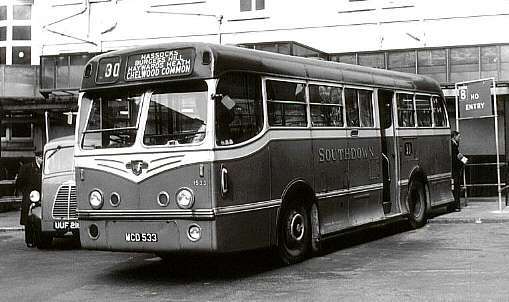
Royal Tiger no. 1533 at Pool Valley, Brighton, prior to its rebuild to front-entrance in 1961.
(Photo: Roy Marshall collection via East Pennine transport group)
Built 1952-53
Chassis: Leyland Royal Tiger PSU1/13
Body; East Lancs DP40R and DP40C. Later converted to B39F and B41F.
Notes: Although spending much of their lives as buses, these vehicles have been included in this list
of coaches because the original bodies were intended to be dual-purpose, i.e. bus or coach.
- 1500 (LUF 500) - c/n 511042, b/n 4814 / B1429, DP40R, deliv.2/52. Based Portsmouth 1954. Rebuilt to B41F o.m.o. bus 1958, initially as an experiment at Portslade. Subsequently the others were converted similarly. Sold 1967.
- 1501 (LUF 501) - c/n 511046, b/n 4815 / B1430, DP40R, deliv.2/52. Based Portsmouth 1954. Rebuilt to B41F o.m.o. bus 1959. To B39F in 1965. Sold 1968.
- 1502 (LUF 502) - c/n 511146, b/n 4819 / B1431, DP40R, deliv.2/52. Based Portsmouth 1954. Rebuilt to B41F o.m.o. bus by 1959. Sold 1968.
- 1503 (LUF 503) - c/n 511148, b/n 4813 / B1432, DP40R, deliv.2/52. Based Portsmouth 1954. Rebuilt to B41F o.m.o. bus around 1960. Sold 1967.
- 1504 (LUF 504) - c/n 511149, b/n 4817 / B1433, DP40R, deliv.2/52. Based Portsmouth 1954. Rebuilt to B41F o.m.o. bus 1959. To B39F in 1965. Sold 1968.
- 1505 (LUF 505) - c/n 511150, b/n 4818 / B1434, DP40R, deliv.2/52. Based Portsmouth 1954. Later based at Brighton. Rebuilt to B41F o.m.o. bus around 1960. To B39F in 1965. Sold 1968.
- 1506 (LUF 506) - c/n 511152, b/n 4816 / B1435, DP40R, deliv.2/52. Based Portsmouth 1954. Rebuilt to B41F o.m.o. bus around 1960. Sold 1968.
- 1507 (LUF 507) - c/n 511153, b/n 4820 / B1436, DP40R, deliv.3/52. Based Portsmouth 1954. Rebuilt to B41F o.m.o. bus around 1959. Sold early 1967 (the first to go).
- 1508 (LUF 508) - c/n 511154, b/n 4812 / B1437, DP40R, deliv.1/52. Based Portsmouth 1954. Rebuilt to B41F o.m.o. bus 1959. Sold 1967.
- 1509 (LUF 509) - c/n 511151, b/n 4821 / B1430, DP40R, deliv.3/52. Based Portsmouth 1954. Rebuilt to B41F o.m.o. bus around 1959. Sold 1967.
- 1510 (MCD 510) - c/n 522057, b/n 4910 / B1439, DP40C, deliv.3/53. Based Portsmouth 1954. Rebuilt to B41F o.m.o. bus 1959. Sold 1967.
- 1511 (MCD 511) - c/n 522058, b/n 4902 / B1440, DP40C, deliv.2/53. Based Brighton area 1954. Rebuilt to B41F o.m.o. bus 1959. Sold 1967.
- 1512 (MCD 512) - c/n 522059, b/n 4912 / B1441, DP40C, deliv.4/53. Based Worthing 1954. Rebuilt to B39F o.m.o. bus 1960. Based Chichester 1960s. Sold 1968.
- 1513 (MCD 513) - c/n 522143, b/n 4913 / B1442, DP40C, deliv.4/53. Based Worthing 1954. Rebuilt to B39F o.m.o. bus 1961. Sold 1967.
- 1514 (MCD 514) - c/n 522144, b/n 4908 / B1443, DP40C, deliv.3/53. Based Brighton area 1954. Rebuilt to B41F o.m.o. bus 1959. Sold 1967.
- 1515 (MCD 515) - c/n 522145, b/n 4914 / B1444, DP40C, deliv.4/53. Based Worthing 1954. Rebuilt to B39F o.m.o. bus 1961. Sold 1968.
- 1516 (MCD 516) - c/n 522146, b/n 4911 / B1445, DP40C, deliv.4/53. Based Brighton area 1954. Rebuilt to B39F o.m.o. bus 1960. Sold 1968.
- 1517 (MCD 517) - c/n 522147, b/n 4909 / B1446, DP40C, deliv.3/53. Based Brighton area 1954. Rebuilt to B41F o.m.o. bus 1959. Sold 1968.
- 1518 (MCD 518) - c/n 522188, b/n 4915 / B1447, DP40C, deliv.4/53. Based Brighton 1954. Rebuilt to B41F o.m.o. bus 1959. Sold 1968.
- 1519 (MCD 519) - c/n 522189, b/n 4907 / B1448, DP40C, deliv.3/53. Based Brighton area 1954. Rebuilt to B39F o.m.o. bus 1960. Sold 1967.
- 1520 (MCD 520) - c/n 522190, b/n 4904 / B1449, DP40C, deliv.3/53. Based Brighton area 1954. Rebuilt to B39F o.m.o. bus 1961. Sold 1968.
- 1521 (MCD 521) - c/n 522191, b/n 4903 / B1450, DP40C, deliv.2/53. Based Brighton area 1954. Rebuilt to B41F o.m.o. bus 1959. Sold 1967.
- 1522 (MCD 522) - c/n 522192, b/n 4906 / B1451, DP40C, deliv.3/53. Based Brighton area 1954. Rebuilt to B39F o.m.o. bus 1960. Sold 1968.
- 1523 (MCD 523) - c/n 522193, b/n 4901 / B1452, DP40C, deliv.2/53. Based Brighton area 1954. Rebuilt to B41F o.m.o. bus 1959, based Chichester 1960s. Sold 1968.
- 1524 (MCD 524) - c/n 522194, b/n 4905 / B1453, DP40C, deliv.3/53. Based Brighton area 1954. Rebuilt to B41F o.m.o. bus 1959. Sold 1967.
- 1525 (MCD 525) - c/n 530213, b/n 4929 / B1454, DP40C, deliv.5/53. Based Horsham 1954. Rebuilt to B39F o.m.o. bus and given cream roof late 1960. Sold 1968.
- 1526 (MCD 526) - c/n 530214, b/n 4927 / B1455, DP40C, deliv.5/53. Based Horsham 1954. Rebuilt to B39F o.m.o. bus and given light green roof late 1960. Sold 1968.
- 1527 (MCD 527) - c/n 530223, b/n 4934 / B1456, DP40C, deliv.6/53. Based Brighton area 1954. Rebuilt to B41F o.m.o. bus 1959, then to B39F in 1963. Sold 1968.
- 1528 (MCD 528) - c/n 530224, b/n 4926 / B1457, DP40C, deliv.5/53. Based Eastbourne 1954. Rebuilt to B39F o.m.o. bus 1960. Sold 1968.
- 1529 (MCD 529) - c/n 530243, b/n 4925 / B1458, DP40C, deliv.5/53. Based Worthing 1954. Rebuilt to B39F o.m.o. bus 1961. Sold 1968.
- 1530 (MCD 530) - c/n 530244, b/n 4930 / B1459, DP40C, deliv.5/53. Based Brighton area 1954. Rebuilt to B39F o.m.o. bus 1960. Sold 1968.
- 1531 (MCD 531) - c/n 530294, b/n 4931 / B1460, DP40C, deliv.5/53. Based Eastbourne 1954. Rebuilt to B41F o.m.o. bus 1959. Sold 1967.
- 1532 (MCD 532) - c/n 530295, b/n 4922 / B1461, DP40C, deliv.4/53. Based Horsham 1954. Rebuilt to B39F o.m.o. bus 1960. Sold 1968.
- 1533 (MCD 533) - c/n 530296, b/n 4924 / B1462, DP40C, deliv.5/53. Based Brighton area 1954. Rebuilt to B39F o.m.o. bus 1961. Sold 1968.
- 1534 (MCD 534) - c/n 530297, b/n 4923 / B1463, DP40C, deliv.4/53. Based Brighton area 1954. Rebuilt to B39F o.m.o. bus 1961. Sold 1968 to McGregor (contractor), Chesterfield.
- 1535 (MCD 535) - c/n 530561, b/n 4936 / B1464, DP40C, deliv.6/53. Based Worthing 1954. Rebuilt to B39F o.m.o. bus 1960. With Morris and Jacombs, Birmingham 1968 (non PSV).
- 1536 (MCD 536) - c/n 530566, b/n 4935 / B1465, DP40C, deliv.6/53. Based Brighton area 1954. Rebuilt to B41F o.m.o. bus 1959. Sold 1968.
- 1537 (MCD 537) - c/n 530580, b/n 4932 / B1466, DP40C, deliv.5/53. Based Worthing 1954. Rebuilt to B39F o.m.o. bus 1961. Sold 1968.
- 1538 (MCD 538) - c/n 530591, b/n 4933 / B1467, DP40C, deliv.6/53. Based Chichester 1954. Rebuilt to B39F o.m.o. bus 1961. Sold 1968.
- 1539 (MCD 539) - c/n 530601, b/n 4928 / B1468, DP40C, deliv.5/53. Based Chichester 1954. Rebuilt to B41F o.m.o. bus 1959. Sold 1968.
LEYLAND ROYAL TIGER - 1600-1649 (Total 50)
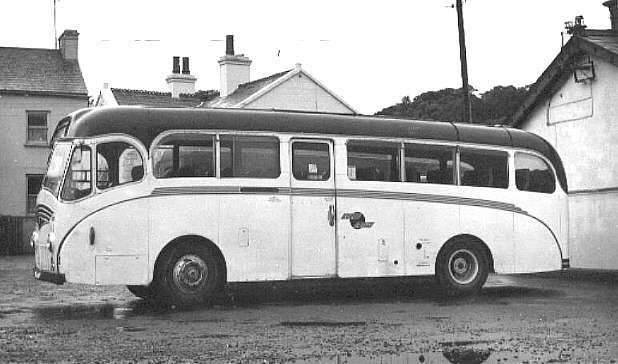
Three different types of bodywork were fitted to this batch, the first twenty examples receiving
Duple Ambassador coachwork with additional typically Southdown brightwork and a small destination box on the front roof. After
retirement by Southdown, no. 1609 was acquired by Lough Swilly in 1965 and renumbered 105. This view, taken in Letterkenny, Co.
Donegal on 21 Sept 1969, shows it in Lough Swilly service. Photo with thanks to John Bristow, via Shane Conway.
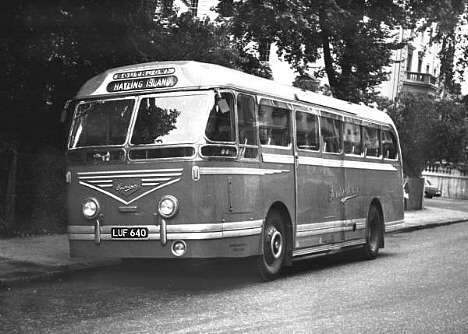
All-Leyland 1640 (LUF 640) on a Hayling Island service. Twenty five of the batch looked like this.
Photo: copyright Keith Harwood.
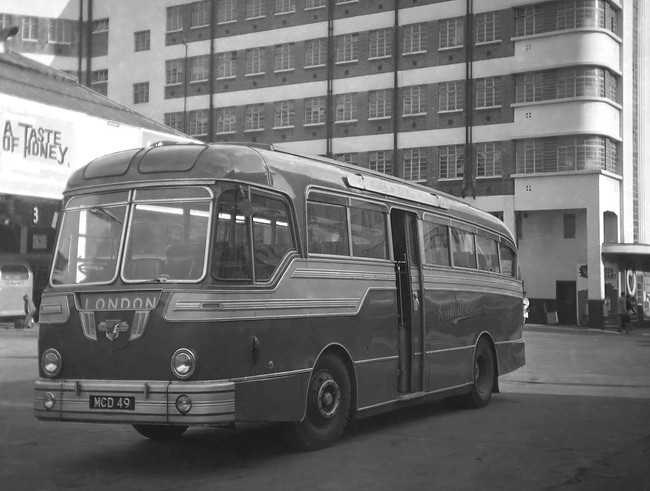
Leyland Royal Tiger no. 1649, the last of the batch, has just disembarked its passengers after a
run up to Victoria Coach Station in London, in 1962. This 41-seat coachwork style was known as the Duple Coronation Ambassador, and
was only built during 1953. The coach was sold in 1966. Photo: Dick Gilbert.
Built 1952-53
Chassis: Leyland Royal Tiger PSU1/15.
Bodies as follows:
1600-1619 Duple Ambassador C41C with sliding roof, for express services.
1620-1644 Leyland C41C with sliding roof, for express services. Similar to the Roadliner design.
1645-1649 Duple Coronation Ambassador C41C with sliding roof. This was basically the Duple Ambassador,
but some 1953 models were named Coronation to celebrate the Queen's coronation that year. These bodies were somewhat heavy and an
unpopular option (East Kent bought two, but that may be all).
Notes: 1619-1644 were converted to dual-purpose DP41C around 1961 with larger destination indicator
boxes, but remained in coach livery. The route numbers, when required, were shown on boards positioned over the front registration
plate.
- 1600 (LUF 600) - c/n 515508, b/n 111/1 / B2352, deliv.4/52. Based Eastbourne 1954. Sold to Dublin Hire Coaches, Ireland 1/65 re-registered RZH 136. Later to Glynn's Coaches, Graigue-na-Spidogue, and derelict with them by 8/76.
- 1601 (LUF 601) - c/n 515483, b/n 111/2 / B2353, deliv.4/52. Based Portsmouth and used by Portsmouth Football Club each season in the 1950s. Sold 1964, possibly to Dublin Hire Coaches. Then with Lough Swilly 1965, then possibly Davies, Leeswood. To Celbridge Hire Coaches, Ireland as EIO 355 in Mar 1966.
- 1602 (LUF 602) - c/n 515484, b/n 111/3 / B2354, deliv.4/52. Based Portsmouth 1954. To Dublin Hire Coaches around 1964, then to Lough Swilly, Derry as no. 103 in 1964. Withdrawn in April 1971 after accident, and expected to be scrapped. To Houston, Carndonagh, Ireland 7/73. Scrapped by 11/92.
- 1603 (LUF 603) - c/n 515491, b/n 111/4 / B2355, deliv.4/52. Based Chichester 1954. Sold 1964 to Ireland, unknown owner. With B.Kavanagh, Urlingford in 1965-66. To Angland, Boherbue by 8/78.
- 1604 (LUF 604) - c/n 520184, b/n 111/5 / B2356, deliv.4/52. Based Portsmouth 1954. Sold to dealer 1964. With John Laing (contractor) 1967.
- 1605 (LUF 605) - c/n 520186, b/n 111/6 / B2357, deliv.4/52. Based Eastbourne 1954. Sold to Dublin Hire Coaches, Ireland 1/65, as OZH 782. To Glynn's Coaches, Graigue-na-Spidogue 2/66; derelict with them 8/76.
- 1606 (LUF 606) - c/n 520188, b/n 111/7 / B2358, deliv.4/52. Based Eastbourne 1954. Sold to dealer 1964. With John Laing (contractor) 1965.
- 1607 (LUF 607) - c/n 520189, b/n 111/8 / B2359, deliv.4/52. Based Worthing 1954. To Dublin Hire Coaches, then to Lough Swilly, Derry as no. 104 in 1964. Withdrawn 4/74. To new owner, Rossnowlagh 6/75 as a fishing hut.
- 1608 (LUF 608) - c/n 520185, b/n 111/9 / B2360, deliv.4/52. Based Worthing 1954. Sold to Churchbridge Motor Services, Cannock 1965.
- 1609 (LUF 609) - c/n 520187, b/n 111/10 / B2361, deliv.4/52. Based Worthing 1954. To Dublin Hire Coaches around 1964, then to Lough Swilly, Derry as no. 105 in 1965. Still with Lough Swilly in 1971 when converted from coach to bus seating (C41C to B43C). Withdrawn 4/74. ?To new owner, Rossnowlagh in 197? and sold for scrap?.
- 1610 (LUF 610) - c/n 520190, b/n 111/11 / B2362, deliv.4/52. Based Portsmouth 1954. Sold 1965.
- 1611 (LUF 611) - c/n 520191, b/n 111/12 / B2363, deliv.4/52. Based Chichester 1954. Sold early 1966.
- 1612 (LUF 612) - c/n 520192, b/n 111/13 / B2364, deliv.4/52. Based Eastbourne 1954. Sold 1965 to Eastbourne Old Comrades Club.
- 1613 (LUF 613) - c/n 520248, b/n 111/14 / B2365, deliv.4/52. Based Brighton area 1954. Sold 1965. With John Laing (contractor) in 1966.
- 1614 (LUF 614) - c/n 520249, b/n 111/15 / B2366, deliv.4/52. Based Worthing 1954. Sold 1966. With Wimpey (contractor) 1967.
- 1615 (LUF 615) - c/n 520434, b/n 111/16 / B2367, deliv.4/52. Based Worthing 1954. Sold to dealer 1966.
- 1616 (LUF 616) - c/n 520433, b/n 111/17 / B2368, deliv.4/52. Based Brighton area 1954. Sold 1965.
- 1617 (LUF 617) - c/n 520543, b/n 111/18 / B2369, deliv.4/52. Based Brighton area 1954. Sold early 1966.
- 1618 (LUF 618) - c/n 520545, b/n 111/19 / B2370, deliv.5/52. Based Brighton area 1954. Sold 1965. Staff bus with Office Cleaning, Urmston, Manchester 1966.
- 1619 (LUF 619) - c/n 520544, b/n 111/20 / B2371, deliv.4/52. Body badly damaged by accident in Spain 8/52. New Duple C41C body (no. 162/11 / B2435) fitted 6/53 and vehicle renumbered 1660. Based Brighton area 1953. Sold 1965.
-
- 1620 (LUF 620) - c/n 521355, b/n B2372, deliv.6/52. Based Eastbourne 1953. Sold late 1963. With O'Brien's Coaches (later renamed Midland Coaches), Portlaoise, Ireland in 1964, still with them in 1966. With P.Kennedy, Dundrum, Tipperary in 1970.
- 1621 (LUF 621) - c/n 521356, b/n B2373, deliv.6/52. Based Eastbourne 1953. Sold to Mexborough and Swinton end of 1963 as no. 106. Had serious accident in August 1967 and was withdrawn.
- 1622 (LUF 622) - c/n 521526, b/n B2374, deliv.6/52. Based Eastbourne 1953. Sold late 1963. With Roman City, Bath 1964-65, then with Western Printing Services, Avonmouth, Bristol in 1966.
- 1623 (LUF 623) - c/n 521358, b/n B2375, deliv.6/52. Based Eastbourne 1953. Sold 1964. With Monk (contractor), Warrington as no. V1139 in 1965.
- 1624 (LUF 624) - c/n 521527, b/n B2376, deliv.6/52. Based Portsmouth 1953. Sold 1963. With United Services (Everett) 1964.
- 1625 (LUF 625) - c/n 520256, b/n B2377, deliv.6/52. Based Portsmouth 1953. Sold 1963. With J. Murphy (contractor), London 1964. With Bowzell, Deal, Kent in 1965 as workers' transport.
- 1626 (LUF 626) - c/n 521525, b/n B2378, deliv.6/52. Based Brighton area 1953. Converted to DP41C with bus-type indicators in 1961. Withdrawn 1965. With Blackford, Isleworth, Middlesex 1966.
- 1627 (LUF 627) - c/n 521565, b/n B2379, deliv.6/52. Based Brighton area 1953. Converted to bus duties 1961. Withdrawn 1965. Sold to Express Office Cleaning Services, Stretford, Manchester 1965.
- 1628 (LUF 628) - c/n 521569, b/n B2380, deliv.6/52. Based Brighton area 1953. Converted to DP41C with bus-type indicators in 1961. Sold 1965 to Monk (contractor), Warrington as their no. V1269.
- 1629 (LUF 629) - c/n 521357, b/n B2381, deliv.6/52. Based Brighton area 1953. Converted to DP41C with bus-type indicators in 1961. Withdrawn 1965.
- 1630 (LUF 630) - c/n 521564, b/n B2382, deliv.7/52. Based Brighton area 1953. Converted to DP41C with bus-type indicators in 1961. Withdrawn 1965. With Sindall (contractor) Cambridge in 1965.
- 1631 (LUF 631) - c/n 521570, b/n B2383, deliv.7/52. Based Portsmouth 1953. Sold 1963. With R. R. Owen, Holyhead 1964.
- 1632 (LUF 632) - c/n 520258, b/n B2384, deliv.7/52. Based Bognor 1953. Converted to bus duties 1961. Withdrawn 1965.
- 1633 (LUF 633) - c/n 520918, b/n B2385, deliv.7/52. Based Littlehampton 1953. Sold end of 1963. With Morley, Droylsden, Manchester 1964.
- 1634 (LUF 634) - c/n 521528, b/n B2386, deliv.7/52. Based Brighton area 1953. Converted to DP41C with bus-type indicators in 1961. Withdrawn 1965. With Balfour-Beatty (contractor) 1966.
- 1635 (LUF 635) - c/n 521566, b/n B2387, deliv.7/52. Based Bognor 1953. Converted to bus duties 1961, based Brighton. Withdrawn 1965.
- 1636 (LUF 636) - c/n 521567, b/n B2388, deliv.7/52. Based Bognor 1953. Converted to DP41C with bus-type indicators in 1961. Withdrawn 1965. With Monk (contractor), Warrington as their V1271 in 1966.
- 1637 (LUF 637) - c/n 521568, b/n B2389, deliv.7/52. Based Portsmouth 1953. Sold to Mexborough and Swinton end of 1963 as no. 107. Then withdrawn and sold by them in 1967.
- 1638 (LUF 638) - c/n 521571, b/n B2390, deliv.7/52. Based Portsmouth 1953. Sold 1964. With Cardinal Godfrey School Development Association, Liverpool in 1966; operated annual trips to France and Spain. Still with them in 1976.
- 1639 (LUF 639) - c/n 521606, b/n B2391, deliv.7/52. Based Portsmouth 1953. Converted to DP41C with bus-type indicators in 1961. Sold to Mexborough and Swinton in 1964 as their no. 104. Withdrawn in 1966 and converted to a towing vehicle with cutaway rear body. Transferred to Yorkshire Traction in 1969 on their takeover of Mexborough and Swinton.
- 1640 (LUF 640) - c/n 521607, b/n B2392, deliv.7/52. Based Portsmouth 1953. Sold to Mexborough and Swinton in 1964 as their no. 105. Then withdrawn and sold by them in 1967.
- 1641 (LUF 641) - c/n 521608, b/n B2393, deliv.7/52. Based Worthing / Littlehamptopn 1953. Sold 1965 to Evans, Bulkington.
- 1642 (LUF 642) - c/n 521609, b/n B2394, deliv.7/52. Based Worthing 1953. Converted to DP41C with bus-type indicators in 1961. Withdrawn 1965. Sold to ??. Then to D. Patton and sons (contractors), Ballymena, N.Ireland in 1967. Withdrawn by 6/91.
- 1643 (LUF 643) - c/n 521610, b/n B2395, deliv.7/52. Based Worthing 1953. Converted to DP41C with bus-type indicators in 1961. Withdrawn 1965.
- 1644 (LUF 644) - c/n 521611, b/n B2396, deliv.7/52. Based Worthing 1953. Converted to DP39C (the only 39-seater?) with bus-type indicators in 1961. Withdrawn 1965. With Stokes, Carstairs in 1965, sold in 1968.
-
- 1645 (MCD 45) - c/n 521452, b/n 125/1 / B2397, deliv.1/53. Based Portsmouth 1953. Earls Court Commercial Motor Show exhibit in September 1952 with various additional embellishments that were removed before service entry. Sold early 1966 to Hughes, Buckley.
- 1646 (MCD 46) - c/n 520691, b/n 125/2 / B2398, deliv.5/53. Based Portsmouth 1953. Sold early 1966 to Stokes, Carstairs - still with them in 1972.
- 1647 (MCD 47) - c/n 520579, b/n 125/3 / B2399, deliv.5/53. Based Portsmouth 1953. Sold early 1966. Acquired by Unit Construction Co.Ltd., Belfast, then bought by 6th Newtownards Scout Troop (for the seats which they wanted for another vehicle). Then bought by Robinson (Coastal Bus Services), Portrush, to be broken up for spares, finally scrapped 1973.
- 1648 (MCD 48) - c/n 520692, b/n 125/4 / B2400, deliv.5/53. Based Portsmouth 1953. Sold early 1966 to Stokes, Carstairs, Scotland. To Keenan, Coalhall, Scotland in 1971.
- 1649 (MCD 49) - c/n 522618, b/n 125/5 / B2401, deliv.5/53. Based Portsmouth 1953. Sold early 1966 to Rhymney Transport Services.
LEYLAND ROYAL TIGER - 1650-1680 (Total 31)
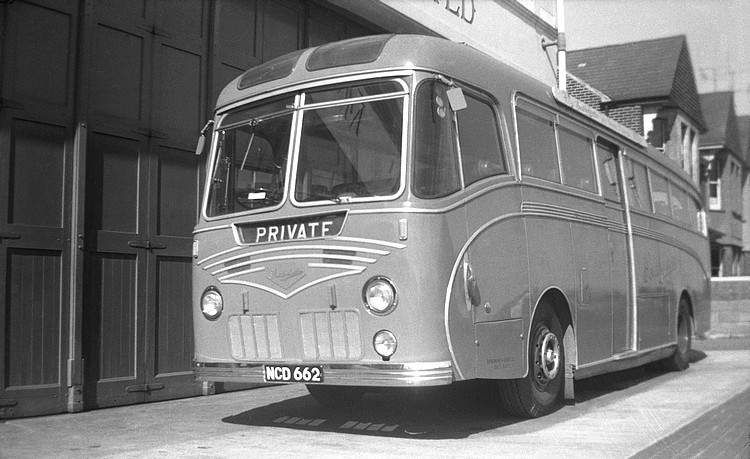
Leyland Royal Tiger no. 1662 (NCD 662) sits outside Southdown's Royal Parade garage on Eastbourne
seafront on 9 April 1961. Typical of the company's general purpose coaches of the period it has a distinctive Southdown styling,
and it survived 12 years in service. Royal Parade garage is now sadly replaced by a block of flats. Photo: Dick Gilbert
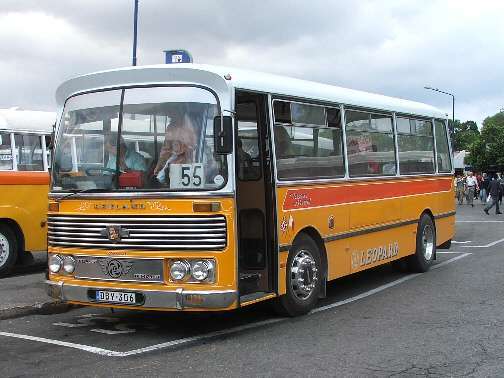
Amazingly, the first of the batch survived into the 21st century in service! Here is the chassis of
1650 (MUF 650) working in Malta in 2006, attached to an Aquilina body and registered DBY 306, despite claiming to be a Leyland
Leopard. Peter Skerry kindly sent the photo and confirmed the chassis number. A surprising discovery.
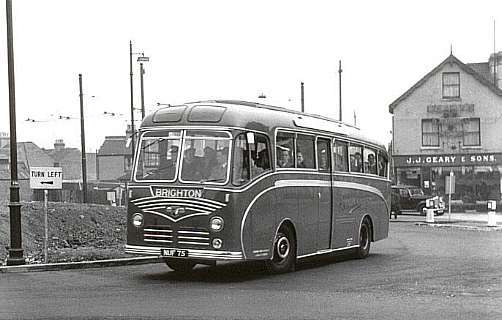
This picture shows Royal Tiger no. 1675, with its Duple body still in the original 41-seat
configuration (which dates the photo to 1954-56, and thanks to Paul Statham for additional information there) is slightly unusual
in that it has a Leyland Royal Tiger badge on the front, instead of the more common Southdown logo. (photo: unknown). At first I
thought that the coach was roaring into Brighton, based on the overhead trolleybus wiring but the correspondence below shows that
I got it all wrong!
Martin Cory wrote: the picture of the Southdown Royal Tiger 835 is not at Brighton at all, but is
actually at what is now called the Lombard Roundabout in Croydon, at the junction of Thornton Road and Purley Way (the A23) and
Canterbury Road and Mitcham Road. The trolleybus wiring overhead was for London Transport route 630 that ran along Mitcham Road, on
its way from West Croydon to Harlesden. At the time the picture was taken Lombard was not there, so I don't actually know if the
new roundabout had a name in the early 1950s. Lombards were certainly there by the early 1960s, although they have gone now, but
the building and the roundabout name remains.
But Jonathan Sheard said: J. J. Geary and sons was (and still is) a Brighton furniture business, so
methinks that Brighton is correct after all.
Martin Cory had the last (and undeniably correct!) word: sorry, but both Jonathan and you are wrong.
J. J. Geary are indeed a furniture and upholstery shop in Brighton, but they are in Newark Place which is a back street, and not
anywhere near a roundabout! I would refer you to the website of David Bradley www.trolleybus.net
- look at route 630 and then look at picture number 556. You will see Geary's clearly in the background, and a trolleybus on
route 630 passing by. It is quite obviously the same location as your picture. The style of the keep left signs and the lamp-posts
on the roundabout (although the tops have been replaced in the later photo, with sodium lights instead of white ones) also confirms
it. I lived in Canterbury road throughout the 1950s and indeed bought my first bike from Geary's in 1957. The man who ran it then
was called Jack Hayward, but he kept the Geary's name as it was well known.
Oh - that wasn't that last word after all. David Isted emailed in July 2019: I have some more
evidence to dispel the location as being in Brighton, and to reaffirm that this photo was indeed taken on the A23 Lombard Roundabout,
Croydon. The building behind the Leyland Tiger was a local garage situated on the corner of Thornton Road and Canterbury Road,
Croydon, and was run by J. J. Geary and sons at the time the photo was taken. Sadly J. J. Geary's garage has long since gone but
Martin Cory (above) is absolutely correct - the Royal Tiger was photographed navigating the A23 Lombard Roundabout on the Croydon/
Thornton Heath boundary.
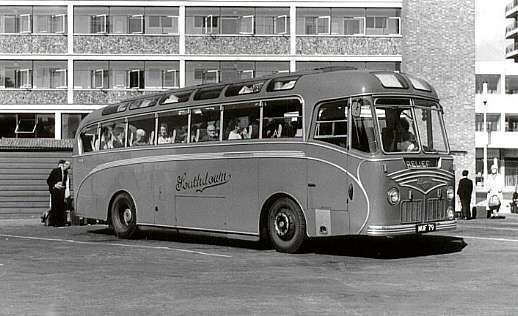
Differing slightly from NUF 75 above, NUF 79 (also with a Duple body, but this time with 41 seats)
is seen in the 1960s after its renumbering to 1839. The chromework and radiator grille are different, it has roof quarterlights
(largely blocked by stored luggage!), and a Southdown badge on the front rather than the Royal Tiger emblem. This vehicle took part
in the 1956 Brighton Coach Rally, winning the Concours d'Elegance class. (Photo: unknown).
Paul Holden tells me that the location of this picture is near the rear entrance to the old Bognor
Regis bus station. Thanks Paul.
Built 1953-54
Chassis: Leyland Royal Tiger PSU1/16
Body: Duple C41C with sliding roof.
- 1650 (MUF 650) - c/n 530332, b/n 162/1 / B2425, deliv.5/53. Based Worthing 1953. Sold 1966. With Wimpey (contractor) 1968. Exported to Malta 1973, fitted with Aquilina body and reregistered DBY 306. Returned to UK around 2015 wearing Leyland Leopard badge. **SURVIVOR**
- 1651 (MUF 651) - c/n 530356, b/n 162/2 / B2426, deliv.5/53. Based Bognor 1953. Sold 1965. With Murphy (contractor), London N5 in 1966.
- 1652 (MUF 652) - c/n 530367, b/n 162/3 / B2427, deliv.5/53. Based Portsmouth 1953. Sold early 1966. With Gorman, Rutherglen, Scotland in 1968.
- 1653 (MUF 653) - c/n 530385, b/n 162/4 / B2428, deliv.5/53. Based Portsmouth 1953. Sold 1965. With Monk (contractor), Warrington as their V1301 in 1966.
- 1654 (MUF 654) - c/n 530387, b/n 162/5 / B2429, deliv.6/53. Based Bognor 1953. Sold 1965. With Monk (contractor), Warrington in 1967.
- 1655 (MUF 655) - c/n 530395, b/n 162/6 / B2430, deliv.6/53. Based Eastbourne 1953. Sold early 1966 to Murphy (contractor), London N5. Then to R. S. Kennedy (contractor), Watford.
- 1656 (MUF 656) - c/n 530462, b/n 162/7 / B2431, deliv.6/53. Based Eastbourne 1953. Sold 1966.
- 1657 (MUF 657) - c/n 530407, b/n 162/8 / B2432, deliv.6/53. Based Eastbourne 1953. Sold to dealer 1966, then to Airtech, Haddenham, Bucks. 1966.
- 1658 (MUF 658) - c/n 530423, b/n 162/9 / B2433, deliv.6/53. Based Portsmouth 1953. Sold early 1966 to Monk (contractor), Warrington as their V1033.
- 1659 (MUF 659) - c/n 530327, b/n 162/10 / B2434, deliv.6/53. Based Bognor 1953. Sold 1965. With Murphy (contractor), London N5 in 1966.
- 1660 - see 1619 above
- 1661 (NCD 661) - c/n 530490, b/n 189/1 / B2445, deliv.2/54. Based Worthing 1954. Sold to dealer 1966. With W. E. R. Robinson (Coastal Bus Service), Portrush, N.Ireland as no. 7 in 1966, but renumbered 8 in 1967. To McCombe Bros. (contractor), Antrim, late 1969. Withdrawn by 6/91.
- 1662 (NCD 662) - c/n 530518, b/n 189/2 / B2446, deliv.3/54. Based Eastbourne 1954. Sold 1966 to Belfast Lions Club for charity work, repainted blue. To Charles Brand Ltd. (contractors), Belfast as staff transport 1968.
- 1663 (NCD 663) - c/n 530531, b/n 189/3 / B2447, deliv.3/54. Based Worthing 1954. Broken up 1963 after accident.
- 1664 (NCD 664) - c/n 530538, b/n 189/4 / B2448, deliv.3/54. Based Portsmouth 1954. Sold 1965. With Murphy (contractor) 1966.
- 1665 (NCD 665) - c/n 530847, b/n 189/5 / B2449, deliv.3/54. Based Brighton area 1954. Sold 1966.
- 1666 (NCD 666) - c/n 530848, b/n 189/6 / B2450, deliv.2/54. Based Brighton area 1954. Sold 1966. With Shaw Bros., Byers Green 1967.
- 1667 (NCD 667) - c/n 530849, b/n 189/7 / B2451, deliv.3/54. Based Eastbourne 1954. Sold 1966.
- 1668 (NCD 668) - c/n 530850, b/n 189/8 / B2452, deliv.3/54. Based Brighton area 1954. Sold 1966. With John Laing (contractor) in 1967.
- 1669 (NUF 69) - c/n 540044, b/n 197/1 / B2453, deliv.3/54. Based Portsmouth 1954. Sold 1966.
- 1670 (NUF 70) - c/n 540046, b/n 197/2 / B2454, deliv.3/54. Based Portsmouth 1954. Renumbered 1841 and downgraded from touring to ordinary coach work in 1962 as C41C. Withdrawn late 1966. With Wimpey (contractor) 1968.
- 1671 (NUF 71) - c/n 540047, b/n 197/3 / B2455, deliv.3/54. Based Bognor 1954. Downgraded from touring to ordinary coach work in 1962 as C41C and renumbered 1842. To Western Welsh, then with Rhondda 1967 as no. 332. With Christian Brothers School, Newry, N.Ireland 1971 in black and brown livery. Withdrawn by 6/91.
- 1672 (NUF 72) - c/n 540049, b/n 197/4 / B2456, deliv.4/54. Based Brighton area 1954. Renumbered 1843 in 1961 and downgraded from touring to ordinary coach work as C41C. Sold to dealer late 1966.
- 1673 (NUF 73) - c/n 540045, b/n 197/5 / B2457, deliv.4/54. Based Brighton area 1954. Renumbered 1844 in 1961 and downgraded from touring to ordinary coach work as C41C. Sold to dealer late 1966. With Wimpey (contractor) 1968.
- 1674 (NUF 74) - c/n 540048, b/n 197/6 / B2458, deliv.4/54. Based Brighton area 1954. In British Coach Rally 1959. Renumbered 1845 and downgraded from touring to ordinary coach work in 1962 as C41C. Withdrawn late 1966. With Wimpey (contractor) 1967.
- 1675 (NUF 75) - c/n 540050, b/n 197/7 / B2459, deliv.4/54. Based Brighton area 1954. Renumbered 835 around 1955, then 1835 around 1956 and converted to C26C tourer. Then became 1692 in 1961 and downgraded to ordinary coach work as C41C. Sold to unknown owner. Then to W. E. R.Robinson (Coastal Bus Services), Portrush, N.Ireland as no. 9 in Feb 1967. Advertised for sale Nov 1968, passed to D.McKeown and Co. (contractor), Ballymena, still with them 1970, but by Jan 1973 it was in the Hillsborough scrapyard of G. A. Beattie.
- 1676 (NUF 76) - c/n 540052, b/n 197/8 / B2460, deliv.4/54. Based Brighton area 1954. Renumbered 836 around 1955, then to 1836 and converted to C26C tourer in 1956. Became no. 1693 around 1961 and downgraded to ordinary coach work as C41C. Sold to unknown owner, then to W. E. R.Robinson (Coastal Bus Services), Portrush, N.Ireland as no. 10 in Feb 1967. Advertised for sale Nov 1968. To McCombe Bros. (contractor), Antrim 1/69. Withdrawn by 6/91.
- 1677 (NUF 77) - c/n 540053, b/n 197/9 / B2461, deliv.4/54. Based Brighton area 1954. Renumbered 837 around 1955, then to 1837 around 1956 and converted to C26C tourer. Then became 1694 in 1961 and downgraded to ordinary coach work as C41C. Withdrawn late 1966.
- 1678 (NUF 78) - c/n 540051, b/n 197/10 / B2462, deliv.4/54. Based Bognor 1954. Renumbered 838 around 1955, then to 1838 around 1956 and converted to C26C tourer. Downgraded to ordinary coach work in 1962 as C41C. Withdrawn late 1966.
- 1679 (NUF 79) - c/n 540054, b/n 197/11 / B2463, deliv.4/54. Based Bognor 1954. Renumbered 839 around 1955, then to 1839 around 1956 and converted to C26C tourer. Won Concours d'Elegance in the 1956 British Coach Rally, Brighton. Downgraded from touring to ordinary coach work in 1962 as C41C. Withdrawn late 1966.
- 1680 (NUF 80) - c/n 540055, b/n 197/12 / B2464, deliv.4/54. Based Chichester 1954. Renumbered 840 around 1955, then to 1840 around 1956 and converted to C26C tourer. Downgraded from touring to ordinary coach work in 1962 as C41C. Withdrawn late 1966.
LEYLAND ROYAL TIGER - 830-834 (Total 5)
Built 1953-55
Chassis: Leyland Royal Tiger (830-833 were PSU1/15, 834 was PSU1/11)
Body: Harrington Wayfarer C26C tourers with sliding roof.
Notes: All renumbered as 1830-1834 around 1960.
- 830 (MUF 430) - c/n 530311, b/n 1184 / B2436. Deliv.4/53. Loaned to Ulster Transport Authority 4/53 to 10/53 for use on Southdown tours in Ireland. Based Brighton area 1954. Renumbered 1830, then again to 1690 in 1961 and converted to C41C (or C28C?). Hired to Aldershot and District 1966, returned in Sept 1966. To Western Welsh, then with Rhondda 1967.
- 831 (MUF 431) - c/n 530348, b/n 1186 / B2437. Deliv.4/53. Loaned to Ulster Transport Authority 4/53 to 10/53 for use on Southdown tours in Ireland. Based Brighton area 1954. Renumbered 1831, then again to 1691 in 1961 and converted to C41C. Hired to Aldershot and District 1966, returned in Sept 1966. To Western Welsh, then with Rhondda 1967.
- 832 (OUF 832) - c/n 550387, b/n 1630. Deliv.5/55. Used on Irish tours by UTA as J9000 from 1956 to 1963, then returned to Southdown and renumbered 1832. Operating in livery of Bucks Coaches, Worthing 1965-66. Withdrawn late 1966.
- 833 (OUF 833) - c/n 550386, b/n 1632. Deliv.5/55. Used on Irish tours by UTA as J9001 from 1956 to 1963, then returned to Southdown and renumbered 1833. Operating in livery of Bucks Coaches, Worthing 1965-66. Withdrawn late 1966.
- 834 (OUF 834) - c/n 550388, b/n 1638. Deliv.6/55. Renumbered 1834. Kept as C26C in 1962 to operate Brighton-Heysham part of Irish tours. Sold to Mexborough and Swinton as their no. 103 in 1965, and withdrawn by them in 1968.
LEYLAND TIGER CUB - 1000-1074 (Total 75)
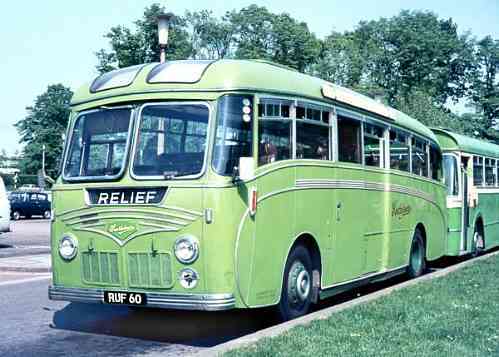
Tiger Cub 1060 (RUF 60) at Crawley. This coach ended up as a contractor's bus with Wimpeys.
Copyright Keith Harwood.
Built 1954-56
Chassis: Leyland Tiger Cub PSUC1/2, with 5.76 litre O.350 engine.
Body: Beadle C37C and C41C
Notes: The Tiger Cub was introduced from 1954 as a response to the increasing weight of the various
Royal Tiger designs previously acquired. Fuel efficiency increased, but so did noise! 1009-1017 were tourers.
- 1000 (OUF 100) - c/n 543223. On loan to Mexborough and Swinton May-Aug 1967 as their no. 111. Then sold 1967. With Wimpey (contractor) in 1968 (in Belfast 1969).
- 1001 (OUF 101) - Sold 1967.
- 1002 (OUF 102) - Sold 1967.
- 1003 (OUF 103) - Withdrawn late 1966. With Sindall (contractors), Cambridge 1967.
- 1004 (OUF 104) - Withdrawn late 1966. With Sindall (contractor), Cambridge 1967.
- 1005 (OUF 105) - Sold 1967. Staff vehicle with Kenning Motorway service stations, 1967.
- 1006 (OUF 106) - Sold 1967. With Wimpey (contractor) 1968.
- 1007 (OUF 107) - Sold 1967. With Wimpey (contractor) 1968.
- 1008 (OUF 108) - c/n 543297. On loan to Mexborough and Swinton May-Aug 1967 as their no. 112. Then sold 1967. With William Press (contractors) 1967.
- 1009 (OUF 109) - Sold 1967.
- 1010 (OUF 110) - Withdrawn 1966 and used as Southdown office, Haywards Heath.
- 1011 (OUF 111) - Sold 1967. With Wimpey (contractor) 1969.
- 1012 (OUF 112) - Sold 1967.
- 1013 (OUF 113) - Sold 1967.
- 1014 (OUF 114) - Sold 1967.
- 1015 (OUF 115) - Sold 1967. With Wimpey (contractor) 1969.
- 1016 (OUF 116) - Withdrawn late 1966. Sold to Smith, Kirkby 1967.
- 1017 (OUF 117) - Operated 4 tours to Moscow on behalf of tour operator L. F. Morland in summer 1958. With Gee Cross Motors, Hyde and Stalybridge 1967.
- 1018 (OUF 118) - Withdrawn late 1966. With Wimpey (contractor) 1968.
- 1019 (OUF 119) - Sold 1967.
- 1020 (OUF 120) - Withdrawn late 1966. With Howells and Withers, Pontllanfraith 1967. With Wimpey (contractor) 1969.
- 1021 (OUF 121) - Withdrawn late 1966.
- 1022 (OUF 122) - Withdrawn late 1966. With Wimpey (contractor) 1968.
- 1023 (OUF 123) - Withdrawn late 1966. Staff transport for Selectro, Farlington, Portsmouth 1967.
- 1024 (OUF 124) - Sold 1967. With Wimpey (contractor) 1968.
- 1025 (OUF 125) - Sold 1967. With Wimpey (contractor) 1968.
- 1026 (OUF 126) - With Wimpey (contractor) 1968. Then to McAlpine.
- 1027 (OUF 127) - Withdrawn late 1966. With Howells and Withers, Pontllanfraith 1967. With Wimpey (contractor) 1969.
- 1028 (OUF 128) - Withdrawn late 1966. With R. I. Davies, Tredegar 1967.
- 1029 (OUF 129) - Withdrawn late 1966. With Howells and Withers, Pontllanfraith 1967. With Wimpey (contractor) 1969.
- 1030 (OUF 130) - Withdrawn late 1966. With Wimpey (contractor) 1968.
- 1031 (OUF 131) - With Wimpey (contractor) 1968.
- 1032 (OUF 132) - Withdrawn late 1966. Sold 1967.
- 1033 (OUF 133) - Based Eastbourne 1961. Broken up for spares and remains scrapped 1966.
- 1034 (OUF 134) - Sold 1967 to Lloyd, Bagillt.
- 1035 (OUF 135) - Sold 1967.
- 1036 (OUF 136) - Sold 1967 to Cam Gears, Clevedon.
- 1037 (OUF 137) - Sold 1967. With R. I. Davies, Tredegar 1967.
- 1038 (OUF 138) - Broken up for spares and remains scrapped 1966.
- 1039 (OUF 139) - Sold 1967 to Sindalls, Cambridge (contractor).
- 1040 (RUF 40) - Sold 1967. With Wimpey (contractor) 1968.
- 1041 (RUF 41) - c/n 555446, Beadle C41C. Sold 1967. With Wimpey (contractors) Belfast 1968. Seen in yard of Walsh Bros (dealer and breaker), Belfast in Dec 1970. Then to Gaelic Football Club, Kilcoo, Hilltown, N.Ireland. Gone by 1991.
- 1042 (RUF 42) - With Hylton Castle Coaches, Sunderland 1968.
- 1043 (RUF 43)
- 1044 (RUF 44) - Based Eastbourne 1961. Sold 1967. With Wimpey (contractor) 1968.
- 1045 (RUF 45) - Sold 1968. With Wimpey (contractor) 1969.
- 1046 (RUF 46) - Sold 1967. With Wimpey (contractor) 1968.
- 1047 (RUF 47) - Sold 1967. With Wimpey (contractor) 1968.
- 1048 (RUF 48) - With Wimpey (contractor) 1968.
- 1049 (RUF 49) - c/n 555640, Beadle C41C. Sold to Wimpey (contractor), Belfast 1968, then to St.Colman's School, Newry in 1971 via Walsh Bros.(dealer), Belfast. Gone by 1991.
- 1050 (RUF 50) - With Wimpey (contractor) 1968.
- 1051 (RUF 51) - Withdrawn c.1969, with Wimpey (contractor) 1970.
- 1052 (RUF 52) - Withdrawn after accident, 1966, and broken up.
- 1053 (RUF 53) - Sold to Wimpey (contractor) 1968.
- 1054 (RUF 54) - To Wimpey (contractor) 1970.
- 1055 (RUF 55) - Sold 1969. With Wimpey (contractor), Belfast 1970. Broken up by Beattie, Hillsborough in 1974.
- 1056 (RUF 56) - Sold 1969.
- 1057 (RUF 57) - Sold to Wimpey (contractor) 1968.
- 1058 (RUF 58) - Sold 1968
- 1059 (RUF 59) - Sold 1968
- 1060 (RUF 60) - With Wimpey (contractor) 1968.
- 1061 (RUF 61) - Based at Portsmouth.
- 1062 (RUF 62) - Sold 1968. With Wimpey (contractor) 1969.
- 1063 (RUF 63) - Sold 1967. With Wimpey (contractor) 1968.
- 1064 (RUF 64) - Broken up for spares after accident damage, and remains scrapped 1966.
- 1065 (RUF 65) - Sold 1969. With Dengate, Rye 1970. With Grimshaw, Brackley (later?) 1970.
- 1066 (RUF 66) - To Wimpey (contractor) 1970.
- 1067 (RUF 67) - Based at Worthing. Sold to Wimpey (contractor) 1968.
- 1068 (RUF 68) - Sold 1968
- 1069 (RUF 69) - With Wimpey (contractor), Belfast 1971. With Rea Racing (N.Ireland) 1975.
- 1070 (RUF 70) - Withdrawn c.1969, with Wimpey (contractor) 1970.
- 1071 (RUF 71) - With Wimpey, late 1960s. Seen at Highland Fabricators, Nigg in 1974.
- 1072 (RUF 72) - Sold to Wimpey (contractor) 1968.
- 1073 (RUF 73) - Sold to Wimpey (contractor) 1968.
- 1074 (RUF 74) - Sold 1968 to Garelochhead Coach Services, Scotland as no. 68 (number not displayed). With Rennie's Lion and Comfort Coaches, Dunfermline 1970 (had been leased by them to Jack, Oakley, but returned at end of 1970). Withdrawn 1971, sold for scrap 1972.
COMMER TS3 / BEADLE INTEGRAL - 1-25 (Total 25)
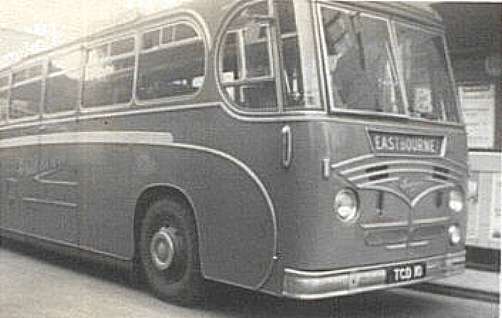
Not the greatest of pictures, I'll grant you, but it does give some idea of the styling of these
two-stroke Beadle/Commer TS3 integral coaches which Southdown acquired in 1956-57 and used largely on express services from London
to the coast because of their fine turn of speed! This is no. 10 (TCD 10), picking up passengers at the Cavendish Place coach
station in Eastbourne in 1961. Photo Dick Gilbert.
Built 1956 (Nos. 1-5) and 1957 (Nos.6-25)
Chassis/Body: Commer TS3 (3-cylinder opposed-piston 2-stroke diesel) integral build with Beadle Mk.
II Rochester C41F bodies (Nos. 1-5 were C41C).
Notes: The last of these were sold in 1969.
- 1 (RUF 101) - c/n JCB689. Sold 1968 to Bryn Motors, Pontallanfraith.
- 2 (RUF 102) - c/n JCB690. Withdrawn 1968. With Marfleet Construction, E.Yorkshire in 1969.
- 3 (RUF 103) - c/n JCB691. Sold 1968. Went to Ireland, became YZM 732. Later to S. Faherty, Moycullen, then to Cotter, Inverin 3/75, To Joyce, Ballinahown by 8/76.
- 4 (RUF 104) - c/n JCB692. Based at Brighton. With Wimpey (contractor) 1968.
- 5 (RUF 105) - c/n JCB693. Sold 1968 to Houghton, Culcheth.
- 6 (TCD 6) - c/n JCB740. Withdrawn 1969. With Flather (contractors), Ellesmere Port 1970.
- 7 (TCD 7) - c/n JCB741. Sold for scrap after accident 1969.
- 8 (TCD 8) - c/n JCB742. Sold 1968 to Bickers, Coddenham (via Frank Cowley, dealer).
- 9 (TCD 9) - c/n JCB743. Broken up for spares 1966.
- 10 (TCD 15) - c/n JCB744. Based Eastbourne 1961. Withdrawn 1969.
- 11 (TCD 11) - c/n JCB745. Sold 1968.
- 12 (TCD 12) - c/n JCB746. Withdrawn after accident 1967. Scrapped 1968.
- 13 (TCD 13) - c/n JCB747. Based at Portsmouth. Sold 1969.
- 14 (TCD 14) - c/n JCB748. Sold late 1968 or early 1969.
- 15 (TCD 15) - c/n JCB749. Sold 1969 to Thyssen (contractor), Llanelli.
- 16 (TUF 16) - c/n JCB716. Withdrawn 1969. With Ward & Goldstone, Salford, as staff bus, winter 1972/73.
- 17 (TUF 17) - c/n JCB717. Sold to I.C.Margo, Penge, London SE20 in 1969.
- 18 (TUF 18) - c/n JCB732. Sold to I.C.Margo, Penge, London SE20 in 1969.
- 19 (TUF 19) - c/n JCB735. Sold 1969. With Jas. Burnside Ltd. (shirt manufacturer), Magherafelt, Co. Derry in 1971-72. With Peter England (also a shirt manufacturer, took over Burnside), Maydown, Derry in 1973, but withdrawn 1975.
- 20 (TUF 20) - c/n JCB737. Based in Eastbourne 1961. Involved in collision with Eastbourne AEC Regent V no. 66 on 22 June 1965 which resulted in the Regent crashing into the Lamb Inn, Old Town. Sold 1968 to Bickers, Coddenham (via Frank Cowley, dealer).
- 21 (TUF 21) - c/n JCB738. Sold to I.C.Margo, Penge, London SE20 in 1969. With Nu-Venture Coaches, Maidstone in 1971.
- 22 (TUF 22) - c/n JCB739. Withdrawn 1969 and sold to Berriman's Coaches, Langtoft, nr Driffield.
- 23 (TUF 23) - c/n JCB751. Sold 1969. With Atomic Power Constructions (contractor) 1970.
- 24 (TUF 24) - c/n JCB752. Sold 1969. With Berriman, Langtoft 1970.
- 25 (TUF 25) - c/n JCB753. Withdrawn 1969. With Atomic Power Constructions (contractor) 1970.
LEYLAND TIGER CUB - 1075-1129 (Total 55)
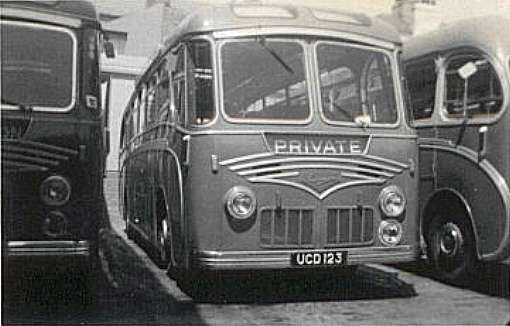
Beadle-bodied Leyland Tiger Cub no. 1123 (UCD 123) parked at Cavendish Place coach station in
Eastbourne in the summer of 1961. Photo: Dick Gilbert.
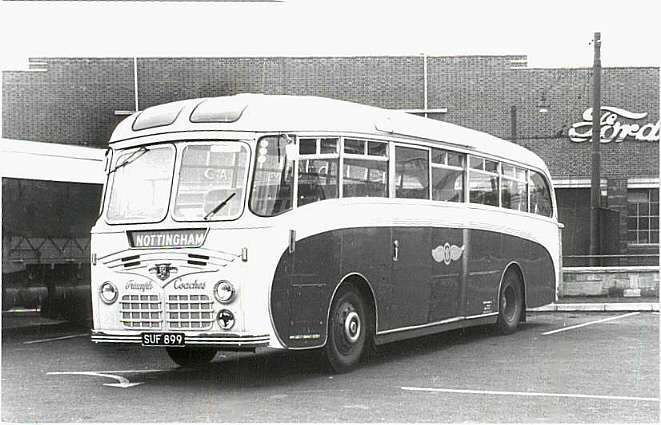
Tiger Cub T1099 (SUF 899) in full Triumph Coaches livery sometime between 1958 and 1966. Does
anyone recognise the location? Photo: P.Yeomans Collection, by kind permission of the PSV
Circle.
Paul Statham kindly sent me the following: the clue is the destination shown, Nottingham, as these
cars (they were always referred to as that by Southdown) were used every weekend on Forces leave services, one of which was to
Nottingham. In the background, you can see trolleybus overhead, and I think that there was a Trent depot next door to a Nottingham
Corporation trolleybus depot, so I believe that is the location. The date is fairly easy as, because the leave services travelled
during the night, all the coaches used (the Triumph-liveried ones plus about 10 regular Southdown cars) were fitted with a second
fog/spot light on the offside within about a year of delivery, thus dating it to no later than December 1958. Thanks Paul.
Vic Smith sent me further information in Nov 2015: Paul is in the right area but I can identify the
precise location. The bus and lorry are parked in the Ice Stadium car park on the west side of Lower Parliament Street. On the
opposite (east) side of Lower Parliament Street can be seen the front of Cartergate Motors (Ford Dealers), which was sited between
the trolleybus depot and the omnibus depot. All features are
visible in this image. The omnibus depot is extant as Manvers Street Depot
seen on the left of this picture. Thanks very much Vic.
Built 1957-58
Chassis: Leyland Tiger Cub PSUC1/2, O.350 5.76 litre engine.
Body: Beadle C32C, C32F, C37C and C41C
Notes: Eight of these were operated by Triumph Coaches, Southsea, and painted blue and cream.
- 1075 (SUF 875) - C41C. Sold 1971.
- 1076 (SUF 876) - C41C. Sold 1969. With Wimpey (contractor) 1970.
- 1077 (SUF 877) - C41C. Sold 1970.
- 1078 (SUF 878) - C41C. Sold 1970. With Wimpey (contractor) in 1973. Operated as non-PSV by Newton, Dingwall o.b.o. Highland Fabricators, Nigg in grey and black livery 1974.
- 1079 (SUF 879) - C41C.
- 1080 (SUF 880) - C41C. Sold 1970. With Wimpey (contractor) in 1973. Operated as non-PSV by Newton, Dingwall o.b.o. Highland Fabricators, Nigg in grey and black livery 1974.
- 1081 (SUF 881) - C41C. Sold 1969. With Wimpey (contractor) 1970.
- 1082 (SUF 882) - C41C. Sold 1970. With Sir Alfred MacAlpine (contractor) 1971.
- 1083 (SUF 883) - C41C.
- 1084 (SUF 884) - C41C. Sold late 1969. With Wimpey (contractor) 1970.
- 1085 (SUF 885) - C41C. Sold 1970.
- 1086 (SUF 886) - C41C. Sold 1971.
- 1087 (SUF 887) - C41C. Sold 1970.
- 1088 (SUF 888) - C41C. Sold 1973.
- 1089 (SUF 889) - C41C. Sold 1969.
- 1090 (SUF 890) - C41C. Later fitted with roof-mounted boat racks. Sold 1971 to Sir Alfred MacAlpine (contractor).
- 1091 (SUF 891) - Beadle C41C, then to C37C in 1959. To C41C again in 1963 and repainted blue/cream for Triumph Coaches fleet. Sold 1969 to St.Patrick's High School, Downpatrick, still with them in 1972.
- 1092 (SUF 892) - Beadle C41C, then to C37C in 1962. To C41C again in 1963 and repainted blue/cream for Triumph Coaches fleet as T1092. Back to Southdown livery in 1968. Sold 1969 to Wimpey (contractor).
- 1093 (SUF 893) - Beadle C41C, then to C37C in 1962. Sold 1969 to Wimpey (contractor).
- 1094 (SUF 894) - C41C. Sold 1969. With Wimpey (contractor) 1970.
- 1095 (SUF 895) - C41C. Sold 1969 to Wimpey (contractor).
- 1096 (SUF 896) - C41C. Sold 1969 to Boland, Reilly Ltd. (contractor), Belfast. Derelict on a building site in Bangor 1974.
- 1097 (SUF 897) - C41C. Triumph Coaches as T1097. Repainted in Southdown livery 1966/67. Sold 1968 to William Press (contractor) as their CH72.
- 1098 (SUF 898) - C41C. Triumph Coaches as T1098. To Southdown livery 1968. Sold 1969. With Wimpey (contractor) 1970.
- 1099 (SUF 899) - C41C. Triumph Coaches as T1099. Repainted in Southdown livery 1966, but retained Triumph titles. Sold 1970.
- 1100 (SUF 900) - C41C. Triumph Coaches as T1100. Broken up for spares and remains scrapped 1966.
- 1101 (SUF 901) - C41C. Triumph Coaches as T1101. Returned to Southdown livery late 1966. Sold 1969 to Wimpey (contractor).
- 1102 (SUF 902) - C41C. Triumph Coaches as T1102. Returned to Southdown livery 1966. Sold to Wimpey (contractor) 1968.
- 1103 (SUF 903) - C41C. Sold 1970.
- 1104 (SUF 904) - C41C. Sold 1970. With Fram-Drysdale (contractor), Paisley, 1970.
- 1105 (SUF 905) - C41C. Sold 1970.
- 1106 (SUF 906) - C41C. Repainted in Triumph Coaches blue/cream livery 1966, T1106. Sold 1969. With Wimpey (contractor) 1970.
- 1107 (SUF 907) - C41C. Sold 1968.
- 1108 (SUF 908) - C41C. Repainted in Triumph Coaches blue/cream livery 1966, T1108. Sold 1969. With Wimpey (contractor) 1970.
- 1109 (SUF 909) - C41C. Based at Portsmouth. Sold 1969 to Wimpey (contractor).
- 1110 (SUF 910) - C41C. With Contract Bus Services, Caerwent (as psv) 1970.
- 1111 (SUF 911) - C41C. Sold 1969. With Wimpey (contractor) 1970.
- 1112 (SUF 912) - C41C. Sold 1970.
- 1113 (SUF 913) - C41C. Sold 1970. With Fram-Drysdale (contractor), Paisley 1970.
- 1114 (SUF 914) - C41C. Sold early 1971.
- 1115 (UCD 115) - c/n 576411. C41F. Repainted in Triumph Coaches livery 1962, given prefix as T1115. Returned to Southdown livery 1968. Sold 1971.
- 1116 (UCD 116) - c/n 576412, deliv 12/57. C41F. Possibly fitted with air suspension at some time. Sold 11/70.
- 1117 (UCD 117) - c/n 576413. C41F. Repainted in Triumph Coaches livery 1962, given prefix as T1117. Sold 1970 to Contract Bus Services.
- 1118 (UCD 118) - c/n 576414. C41F. Sold 1970.
- 1119 (UCD 119) - c/n 576415 C41F. Sold to William Press (contractor) 1970.
- 1120 (UCD 120) - c/n 576964. C37F. Used for tours of Ireland in the summers of 1958 and 1959.
- 1121 (UCD 121) - c/n 576965. C37F. Sold 1970.
- 1122 (UCD 122) - c/n 576966. C37F. Based Eastbourne 1961. Sold to William Press (contractor) 1970.
- 1123 (UCD 123) - c/n 576968. C37F. To William Press (contractor) 1970.
- 1124 (UCD 124) - c/n 576967. C37F. Based at Brighton. Sold to Yates Tours, Runcorn in 1970.
- 1125 (UCD 125) - c/n 577100. C37F. Competed in 1958 British Coach Rally at Brighton. To Jackson, Chorley 1970.
- 1126 (UCD 126) - c/n 577101. C41F. Triumph Coaches T1126. Sold 1970.
- 1127 (UCD 127) - c/n 577102. C41F. Triumph Coaches T1127. Sold 1970.
- 1128 (UCD 128) - c/n 577103. C37F. Altered to C30F in 1963, and back to C32F in 1964. Reputed (inaccurately) to have been the first British coach to make a journey to Moscow. Sold to Yates Tours, Runcorn in 1970.
- 1129 (UCD 129) - c/n 577104. Delivered Jan 1958 as C32F (or C37F?), in light blue and cream livery of Linjebuss, Sweden, for British tours. To C33F in 1962. Repainted in Southdown livery 1/64 and converted to C41F. Sold 1970 to Wimpey (contractor).
COMMER TS3 - 26-40 (Total 15)
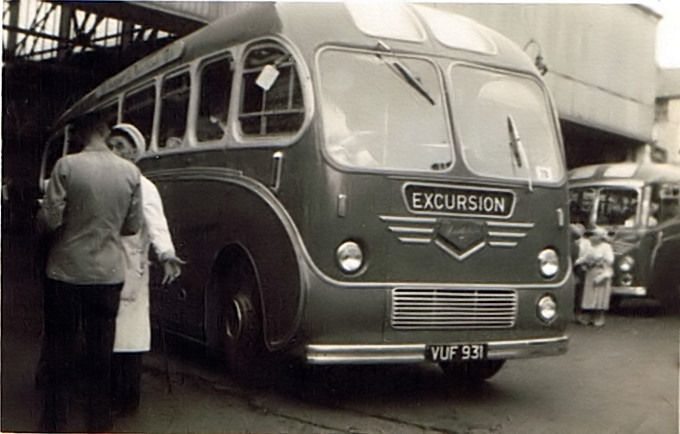
I know I'm late, but I was caught in traffic... pleads the driver perhaps, when Southdown Commer
Avenger no. 31 arrives at the coach station at Cavendish Place Eastbourne in 1961. Coaches had to drive right through the garage
and out the other side to reach the passenger embarkation area to the right of this picture. This depot finally closed for PSV
business in 2002, having had thousands of fascinating vehicular visitors through the years. Photo: Dick Gilbert.
Built 1959
Chassis: Commer TS3 Avenger IV.
Body: Burlingham C35F (modified Seagull design). Southdown's first Burlingham acquisitions since the
1930s.
- 26 (VUF 926) - Based Eastbourne 1960. Sold 1971.
- 27 (VUF 927) - Hired to City of Oxford 1968-69 for excursion and private hire work.
- 28 (VUF 928) - Based Eastbourne 1961. Hired to City of Oxford 1968-69 for excursion and private hire work. Sold 1971. With Cooper and Clayton (contractor) Macclesfield 1972.
- 29 (VUF 929) - Won Class B prize in British Coach Rally 1959. Sold early 1972.
- 30 (VUF 930) - Sold 1971.
- 31 (VUF 931) - Sold 1971.
- 32 (VUF 932) - Based at Chichester. Sold 1971. Later with Liverpool Community Association, and St. Barnabus, Warrington. Apparently preserved by David Long at some point. With Collins, Moreton 1982.
- 33 (VUF 933) - Sold 1971.
- 34 (VUF 934) - Based at Brighton. Sold 1971.
- 35 (VUF 935) - Sold 1971.
- 36 (VUF 936) - Sold 1971. With Wimpey (contractor) in 1973.
- 37 (VUF 937) - Sold 1971.
- 38 (VUF 938) - Sold 1971.
- 39 (VUF 939) - Sold 1971.
- 40 (VUF 940) - Sold 1971, operating in Rawtenstall area 1973.
COMMER AVENGER - 41-55 (Total 15)
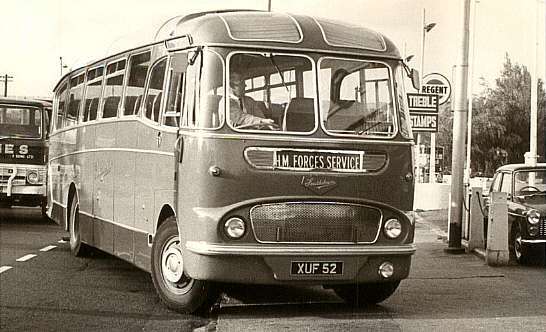
Commer Avenger no. 52 returning from an H. M. Forces service in the 1960s. The distinctive gaping
mouth of the Harrington Crusader was unmistakeable. Michael Rolfe informed me that it is turning into Southdown's famous Hilsea bus
garage on the northern outskirts of Portsmouth. (photo: unknown)
Built 1959-60
Chassis: Commer Avenger IV (Commer TS3 two-stroke engine)
Body: Harrington Crusader C35F
Notes: The original cream roofs were repainted light green around 1962-63.
- 41 (XUF 41) - Delivered 12/59. Sold 1971.
- 42 (XUF 42) - Sold 1971.
- 43 (XUF 43) - Competed in the 1960 British Coach Rally, Brighton. Sold 1971.
- 44 (XUF 44) - Sold 1971.
- 45 (XUF 45) - Sold 1971. With Campbell and Isherwood, Howden (for staff transport) 1972.
- 46 (XUF 46) - Sold 1971.
- 47 (XUF 47) - Sold 1971.
- 48 (XUF 48) - Sold 1971. With Wimpey (contractor) in 1973.
- 49 (XUF 49) - Sold 1971.
- 50 (XUF 50) - Sold 1971. With Campbell and Isherwood, Howden (for staff transport) 1972.
- 51 (XUF 51) - Sold 1971.
- 52 (XUF 52) - Sold 1971.
- 53 (XUF 53) - Sold 1971. With Maddock, Macclesfield 1972.
- 54 (XUF 54) - Sold 1971. With Wallace School of Driving, Nottingham 1973.
- 55 (XUF 55) - Sold 1971.
LEYLAND TIGER CUB - 1130-1144 (Total 15)
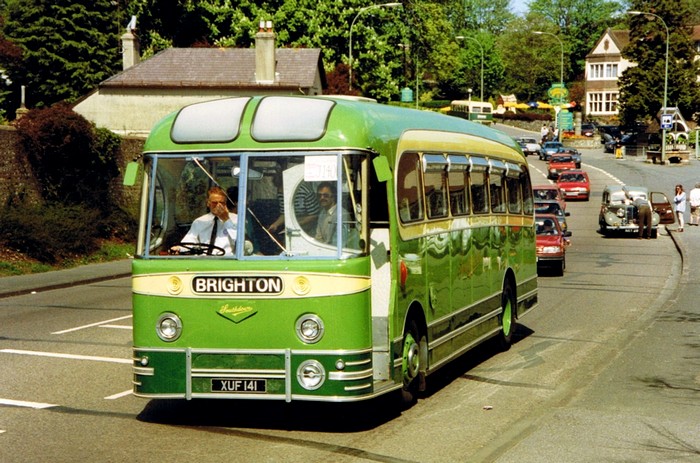
This is Tiger Cub coach no. 1141 (XUF 141), the only survivor of the batch, passing through
Patcham on 1 May 1994. The bodywork is almost a standard Weymann Fanfare design. Mark Piper emailed me to say that he was on this
coach at the time! His father (an ex Southdown employee) had just completed its restoration and was on his way to Brighton to take
some old friends out for a trip to Beaulieu Motor Museum in it. Thanks to Mark for the info. Photo: Dick Gilbert.
In August 2014 I received another interesting email from Mark's father, John Piper: Browsing
through your feature on Southdown coaches you show a picture of me driving my preserved coach on the London to Brighton run on the
1 May 1994. I served my time as an apprentice at Portslade Works from 1959 for five years, returned as Assistant Chief Engineer in
1972, and I was especially proud to have preserved this coach which I purchased from Eagle Coaches, Bristol in 1992. Thank you John.
Built early 1960
Chassis: Leyland Tiger Cub PSUC1/2
Body: Weymann Fanfare C37F
Notes: A further ten identical vehicles were delivered in 1962. The original cream window surrounds
were repainted light green around 1962-63.
- 1130 (XUF 130) - c/n 595884, b/n M9023, deliv.1/60. To C41F by 1973. Withdrawn 1973. With Thomas, Llangadog 1974.
- 1131 (XUF 131) - c/n 595885, b/n M9025, deliv.1/60. To C41F in Apr 1973. Withdrawn 1973.
- 1132 (XUF 132) - c/n 595899, b/n M9024, deliv.1/60. To C41F by 1973. Withdrawn 1973.
- 1133 (XUF 133) - c/n 595915, b/n M9026, deliv.1/60. Based Eastbourne 1961. To C41F by 1973. On loan to City of Oxford 1973, but withdrawn later that year.
- 1134 (XUF 134) - c/n 595969, b/n M9031,deliv.1/60. To C41F by 1973. Withdrawn 1973.
- 1135 (XUF 135) - c/n 595970, b/n M9029, deliv.1/60. To C41F by 1973. On loan to City of Oxford 1973, but withdrawn later that year.
- 1136 (XUF 136) - c/n 595984, b/n M9022, deliv.1/60. To C41F in Apr 1973. Withdrawn 1973, sold to Burch Engineering, Billingshurst, W.Sussex, for staff transport. Still active in 1979.
- 1137 (XUF 137) - c/n 595998, b/n M9027, deliv.1/60. Withdrawn 1973 and sold to Wimpey (contractor), Belfast. For sale 1975, but seen at J. P. and R. C. L., Mallusk, possibly bought. Then to Church of the Nazarene, Eden. Gone by 1991.
- 1138 (XUF 138) - c/n 596016, b/n M9032, deliv.1/60. Withdrawn 1973 and sold to Wimpey (contractor).
- 1139 (XUF 139) - c/n 596196, b/n M9030, deliv.1/60. Withdrawn 1973 and sold to Wimpey (contractor), Belfast. Later to R. I. A., Dublin. scrapped by 11/92.
- 1140 (XUF 140) - c/n 595900, b/n M9028, deliv.1/60. Withdrawn 1973 and sold to Wimpey (contractor), Belfast.
- 1141 (XUF 141) - c/n 596709, b/n M9035, deliv.3/60. To C39F in Apr 1973. Withdrawn 1973, sold to Smith, Upper Heyford. **SURVIVOR** Southdown 1141 Group, Worthing.
- 1142 (XUF 142) - c/n 596723, b/n M9036, deliv.4/60. Competed in the 1960 British Coach Rally, Brighton. picture here. To C41F in Apr 1973. Withdrawn 1973, sold to Smith, Upper Heyford.
- 1143 (XUF 143) - c/n 596753, b/n M9034, deliv.2/60. Withdrawn 1973, sold to Wimpey (contractor).
- 1144 (XUF 144) - c/n 596793, b/n M9033, deliv.2/60. To C41F in Apr 1973. Withdrawn 1973, sold to Smith, Upper Heyford.
LEYLAND LEOPARD - 1700-1729 (Total 30)
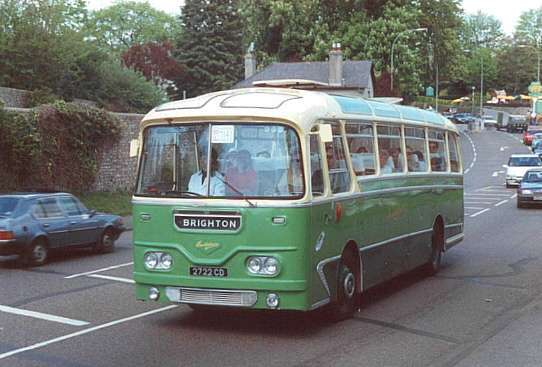
The Southdown Harrington Cavaliers were probably the company's best known coaches of the era, and
this is no. 1722 (2722 CD), seen here sailing through Patcham like a galleon, on the 1994 Historic Commercial Vehicle Society
London to Brighton run. Four examples survive in preservation, and they are all (appropriately) based in Sussex. Photo: Dick Gilbert.
Built 1961
Chassis: Leyland Leopard L2T, O.600 engine, 30' long, 8' 2.5" wide, air suspension.
Body: Harrington Cavalier C28F. Most (if not all) reseated to C41F later.
Notes: Originally with cream roofs, they were repainted with light green roofs from 1962.
- 1700 (2700 CD) - c/n 610010, b/n 2470, deliv 3/61. From C28F to C41F in 1967. Sold 1975.
- 1701 (2701 CD) - c/n 610012, b/n 2472, deliv 3/61. From C28F to C41F in 1967. Sold 1975.
- 1702 (2702 CD) - c/n 600712, b/n 2471, deliv 3/61. Sold 1975 to Wimpey (contractor) via a dealer.
- 1703 (2703 CD) - c/n 610011, b/n 2473, deliv 3/61. From C28F to C41F 1970. From C41F to C39F in 1973 or 74. Hired to Crosville 1974. With Wimpey (contractor) 1975. **SURVIVOR**, 1703 Group, Worthing, to Robins, Halnaker, W.Sussex 2010.
- 1704 (2704 CD) - c/n 610013, b/n 2474, deliv 3/61. From C41F to C39F in 1973 or 74. With Wimpey (contractor) 1975-77, in Merthyr Tydfil area.
- 1705 (2705 CD) - c/n 610188, b/n 2475, deliv 4/61. Won 2nd prize in Concours competition at Brighton Coach Rally 1961. From C28F to C41F 1970. From C41F to C39F in 1973 or 74. With Wimpey (contractor) 1975.
- 1706 (2706 CD) - c/n 610180, b/n 2476, deliv 4/61. From C28F to C41F in 1970. From C41F to C39F in 1973 or 74. Sold 2/75.
- 1707 (2707 CD) - c/n 610181, b/n 2478, deliv 4/61. From C28F to C41F in 1970. From C41F to C39F in 1973 or 74. Sold c.1975.
- 1708 (2708 CD) - c/n 610189, b/n 2477, deliv 4/61. From C28F to C41F in 1970. From C41F to C39F in 1973. Sold 1974 to Cardinal Godfrey High School, Liverpool. **SURVIVOR** In use 2009 as a well-travelled (recently to France and Spain!) mobile home based near Junction 6 of the M57, Merseyside.
- 1709 (2709 CD) - c/n 610190, b/n 2479, deliv 5/61. From C28F to C41F in 1970. To C39F 1975. Sold 1975.
- 1710 (2710 CD) - c/n 610268, b/n 2480, deliv 5/61. From C28F to C41F in 1970. To C39F 1975. Sold 1975.
- 1711 (2711 CD) - c/n 610270, b/n 2481, deliv 5/61. To C39F and sold 1975.
- 1712 (2712 CD) - c/n 610287, b/n 2482, deliv 5/61. To C39F and sold 1975.
- 1713 (2713 CD) - c/n 610269, b/n 2483, deliv 5/61. Hired to Crosville 1974, based Macclesfield, then to Crewe. Sold 1975.
- 1714 (2714 CD) - c/n 610288, b/n 2484, deliv 5/61. To C39F and sold 1975.
- 1715 (2715 CD) - c/n 610338, b/n 2485, deliv 5/61. Hired to Crosville 1974. To C39F and sold 1975.
- 1716 (2716 CD) - c/n 610339, b/n 2486, deliv 6/61. To C41F in 1970. On loan to London Country, summer 1971.
- 1717 (2717 CD) - c/n 610340, b/n 2487, deliv 6/61. Hired to Crosville 1974.
- 1718 (2718 CD) - c/n 610377, b/n 2488, deliv 6/61. To C41F in 1971.
- 1719 (2719 CD) - c/n 610378, b/n 2489, deliv 6/61. To C41F in 1971. To C39F in 1973, with low-back seats.
- 1720 (2720 CD) - c/n 610399, b/n 2490, deliv 6/61. To Wimpey (contractor) by 1980. Working for Snamprogetti (Nederland) as principals from August 1980, probably at the Milford Haven oil refineries. Last taxed (as Private) in July 1982.
- 1721 (2721 CD) - c/n 610398, b/n 2491, deliv 6/61.
- 1722 (2722 CD) - c/n 610431, b/n 2492, deliv 6/61. **SURVIVOR** Baker, W.Hoathly, Sussex.
- 1723 (2723 CD) - c/n 610432, b/n 2493, deliv 6/61. To C39F in 1973, with low-back seats. Sold 2/75.
- 1724 (2724 CD) - c/n 610430, b/n 2496, deliv 7/61. **SURVIVOR** Elliott & Burtenshaw, Crawley.
- 1725 (2725 CD) - c/n 610513, b/n 2494, deliv 6/61.
- 1726 (2726 CD) - c/n 610514, b/n 2495, deliv 7/61. **SURVIVOR** Bob Watts, Five Ashes, East Sussex.
- 1727 (2727 CD) - c/n 610569, b/n 2497, deliv 7/61. From C41F to C39F in 1974. Sold c.1975.
- 1728 (2728 CD) - c/n 610570, b/n 2498, deliv 7/61.
- 1729 (2729 CD) - c/n 610571, b/n 2499, deliv 7/61. From C28F to C41F in 1971. From C41F to C39F in 1974. Sold c.1975.
LEYLAND LEOPARD - 1730-1744 (Total 15)
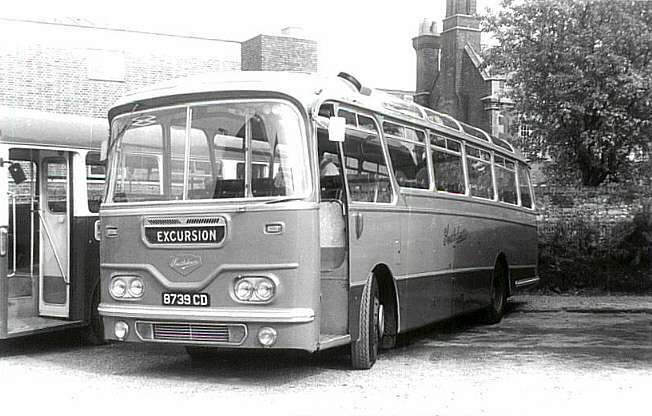
Southdown Leopard no. 1739 (8739 CD) in the 1960s. Photo: T. Knowles Collection, by kind permission
of the PSV Circle.
Built 1961-62
Chassis: Leyland Leopard L2, O.600 engine, 31' 5" long, 8' 2.5" wide. The last two (1743-44) were
Leopard PSU3.3RT, 36 feet long.
Body: Harrington Cavalier 315 C28F or C31F. Many later became C41F. Nos. 1743 and 1744 were Cavalier
36, C49F.
- 1730 (8730 CD) - c/n 611705, b/n 2547, delivered to Eastbourne 11/61. From C28F to C41F in 1971. From C41F to C39F in 1974. Hired to Crosville 1974, based Macclesfield. Sold 1975.
- 1731 (8731 CD) - c/n 611706, b/n 2548, deliv 11/61. From C28F to C41F in 1971. Loaned to Alder Valley 1973. From C41F to C39F in 1974. Sold 1975.
- 1732 (8732 CD) - c/n 611707, b/n 2549, deliv 11/61. From C28F to C41F in 1971. Sold c.1975.
- 1733 (8733 CD) - c/n 611744, b/n 2550, deliv 11/61. From C28F to C41F in 1971. To C39F in 1973. Sold 1975.
- 1734 (8734 CD) - c/n 611745, b/n 2551, deliv 11/61. From C28F to C41F in 1971. Sold 2/75.
- 1735 (8735 CD) - c/n 611974, b/n 2552, deliv 12/61. With Tillings Travel 1974 as their no. 9704.
- 1736 (8736 CD) - c/n 611983, b/n 2553, deliv 12/61. C28F. Overall runner-up, British Coach Rally, Brighton 1962. Sold 1972 to Tillings Travel as their no. 9705. Still with them in 1974.
- 1737 (8737 CD) - c/n 612033, b/n 2554, deliv 12/61. Sold 1972 to Tillings Travel as their no. 9706. Still with them in 1974.
- 1738 (8738 CD) - c/n 612025, b/n 2555, deliv 12/61. C28F. To C41F in 1967. Loaned to Alder Valley and then Western National / Royal Blue (repainted by them as no. 2203) 1973. Sold early 1974.
- 1739 (8739 CD) - c/n 612145, b/n 2556, deliv 12/61. Loaned to Alder Valley and then Western National (repainted by them as no. 2204) 1973. Sold early 1974.
- 1740 (8740 CD) - c/n 612144, b/n 2595, deliv 3/62. C28F. Sold 1972 to Tillings Travel as their no. 9707. Still with them in 1974.
- 1741 (8741 CD) - c/n 612217, b/n 2596, deliv 3/62. C28F. Sold 1972 to Tillings Travel as their no. 9708. Still with them in 1974.
- 1742 (8742 CD) - c/n 612216, b/n 2597, deliv 3/62. C28F. Sold 1972 to Tillings Travel as their no. 9709. Still with them in 1974.
- 1743 (8743 CD) - Leopard PSU3.3RT, 36 foot C49F.
- 1744 (8744 CD) - Leopard PSU3.3RT, 36 foot C49F.
TOTAL 401 ( with 9 survivors - 826, 828, 1141, 1650, 1703, 1708, 1722, 1724 and 1726)
For more Southdown buses see the Southdown
Leyland Tigers - pre-war coaches, the Southdown Leyland Tigers - pre-war
buses, the Southdown Leyland Tigers - all post-war vehicles, and the
Guy Arab utility buses.
For many other buses, have a look at all the other profiles on the Classic
Buses menu page.
SOME LINKS WITHIN THIS WEBSITE:
Home
Email
Links
THE COMPLETE WEBSITE MENU
Events Diary
Halfcab list
Small-Ads
Classic Irish Buses
Classic Manx Buses
SB
























